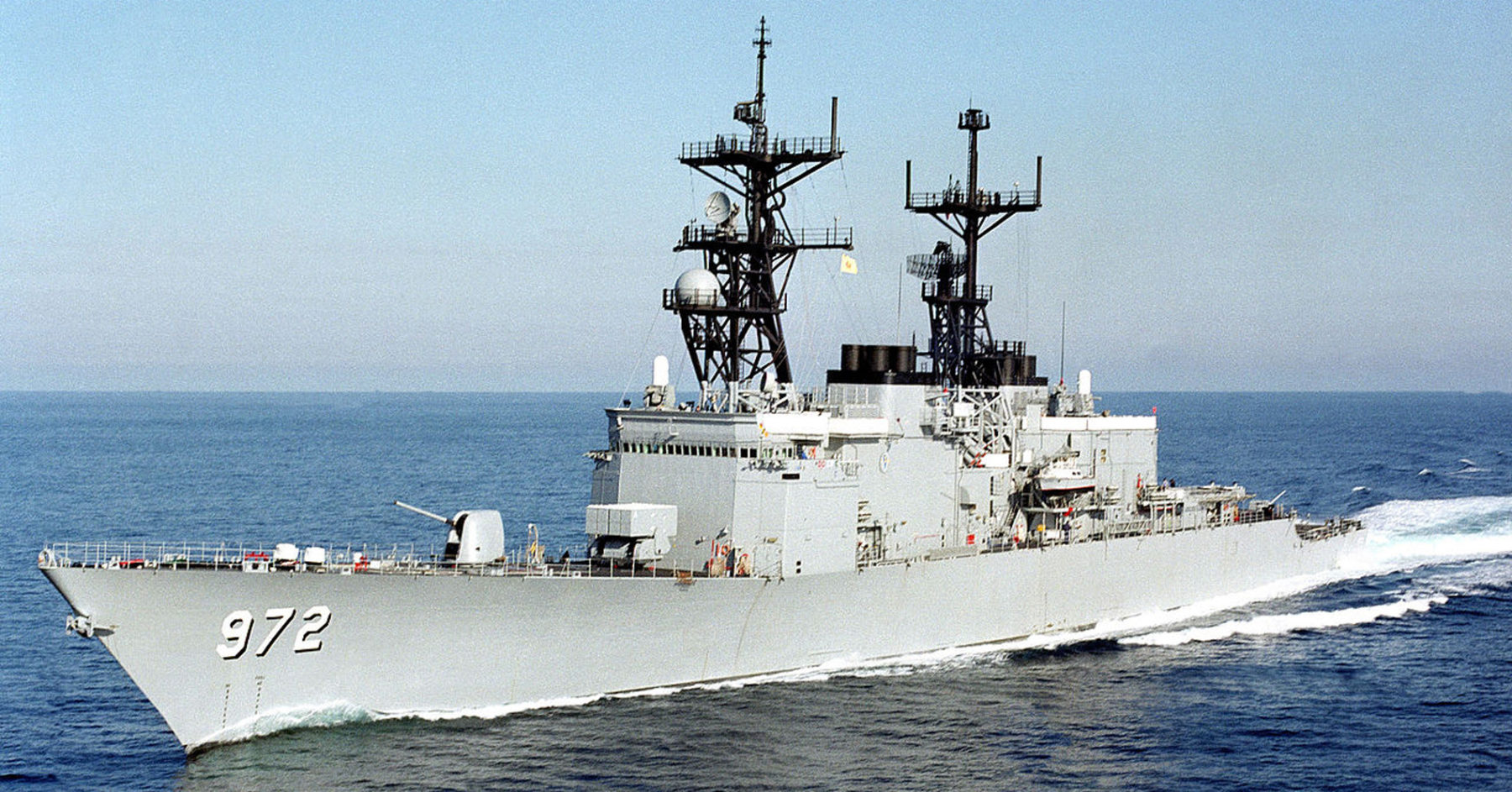
 Guided Missiles Destroyers
Guided Missiles Destroyers
30 ships (DD 963-DD 997) 1975-2020:
USS Spruance, Paul F. Foster, Kinkaid, Hewitt, Elliot, Arthur W. Radford, Peterson, Caron, David R. Ray, Oldendorf, John Young, Comte de Grasse, O’Brien, Merrill, Briscoe, Stump, Conolly, Moosbrugger, John Hancock, Nicholson, John Rodgers, Leftwich, Cushing, Harry W. Hill, O’Bannon, Thorn, Deyo, Ingersoll, Fife, Fletcher, Hayler
Cold War US DDs:
Fletcher DDE class | Gearing DDE class | Gearing FRAM I class | Sumner FRAM II class | Forrest Sherman class | Mitscher class | Farragut class | Norfolk class | Charles F. Adams class | Spruance classDesign Development
The origin of the program dater back from the Vietnam war. It was realized that the old FRAM WWII era Sumner and Gearing leftovers were no longer credible as a naval asset in ths current changing events, they were small at 3,500-4,000 ton and only carried a 8-cell ASROC, four obsolete 5-inch/38 guns, two triple Mk32 ASW torpedo launchers, the staff considering “sitting ducks” to anti-ship missiles. They were limited also in their ASW capabilities (their only saving grace), lacking proper helicopters (the failure of DASH made them even elss relevan than Frigates like the Knox class) and still, they packed some 400 sailors in poor living conditions going back to 1942 emergency wartime specifications. Morale was low, capabilities were poor and yet they were still costly to operate, and had been costly to upgrade. It was more than time to replace them, as soon as possible.
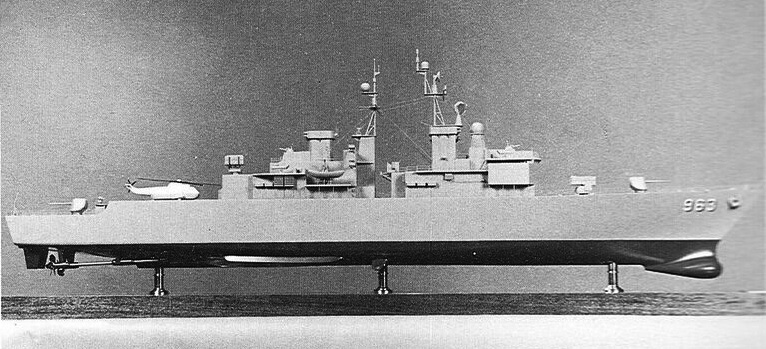
The 1972 Ingalls model, showing many differences with the final design (German publication).
The other incentive as the much better array of Soviet submarines in construction. New SSNs introduced since the very fast “November” class sent shockwaves in the admiralty board. The old FRAM were fas enough but lacked modern ASW capabilities while the Knox class were too slow and not enough. Later this was solved by the adoption of the Oliver Hazard Perry class to replace the Knox from 1975, so about at the same time as the new DDX class.
But at the end of the 1968, the US Navy started a competition for a new class of guided missile ships, more suitable to carrier battle groups protection and initially planned to be just upscaled and upgraded KNOX-class ships. Many proposals were made by several yards, including nuclear-powered ships. The program was called “DDX”. The competition ended when Ingalls Shipbuilding was awarded the contract for the whole class.
The DDX competition
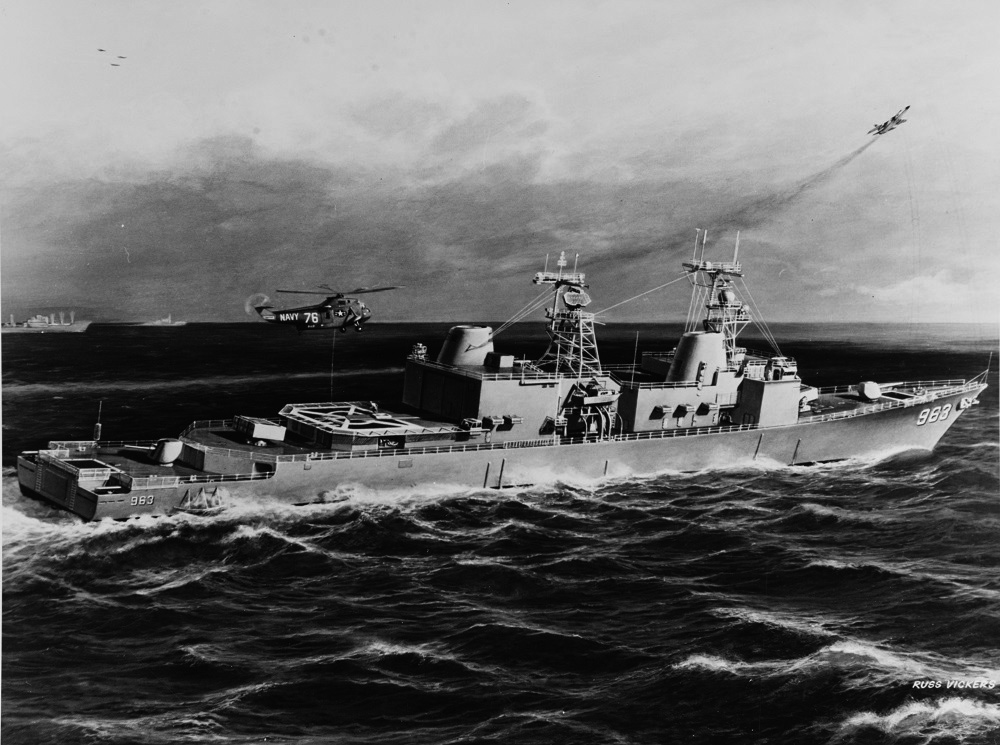
Artist impression of the DDX
The new DDX was later named in honor of U.S. Navy Admiral Raymond A. Spruance, central figure after Nimitz and Halsey in the Asiatic-Pacific Theater in WW2 notably at the Battle of Midway and Philippine Sea. The man passed out on December 13, 1969 just when this destroyer class was studied.
They were originally designed to escort a carrier group, and primarily to be used for anti-submarine warfare (ASW) but still with point-defense anti-aircraft warfare (AAW) missiles unlike the Chalres F. Adams which focused on SAM defence. They were also to have limited anti-ship capabilities, but that was no different than previous designs, except for the gun armament, to be further reduced. As time progressed, the final design was not larger than anything built before, especially for an ASW-oriented destroyer, but it had a number of innovations as well:
-Gas turbine propulsion (a first for that type of ship)
-Flight deck and hangar for up to two medium helicopters (for better ASW range and tracking)
-All-digital weapons (a new centralized battle system, between the sensors, sonars, ASW TTs and ASROC)
-An Automatic 127 mm (5-inch) gun, radically different compared to the previous two 5-inch (127 mm)/54 caliber Mark 42 guns
And this was just the most outstanding list.
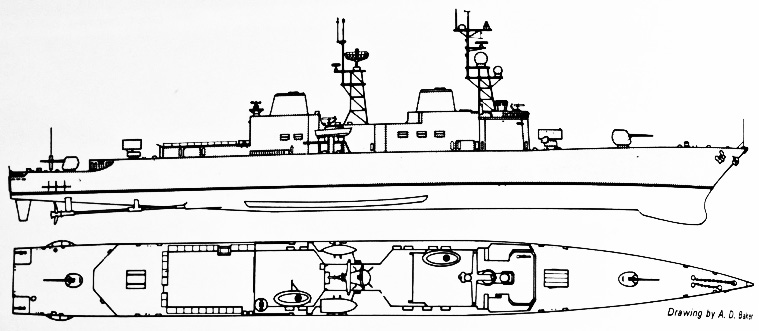
Initial design in 1973
The design being tasked of the defense of nuclear aircraft carrier task forces, it was indeed tailored to be efficient against the latest generation of Soviet nuclear powered submarines and this was reflected in their size, going for for greater seakeeping ability in all weather conditions, in order to track down SSNs whatever the conditions, something still somewhat difficult for earlier flush-deck ships. In the end, they ended more than twice as large as a World War II destroyer and to the scale of that era’s cruiser, with a light cruiser displacement. This was quite an amazing upscaling. The new ships indeed were going in 1971, when the design was approved against missiles SSGs like the Juliet, Echo and Charlie types, SSKs such as the mass-produced Foxtrot, the just revealed Tango class, November and Victor I-II. The K-3 (early November class) made a strong impression by following USS Enterprise at 31 knots on January 17, 1968. This was a wakeup call for the admiralty to get better destroyers.
Construction
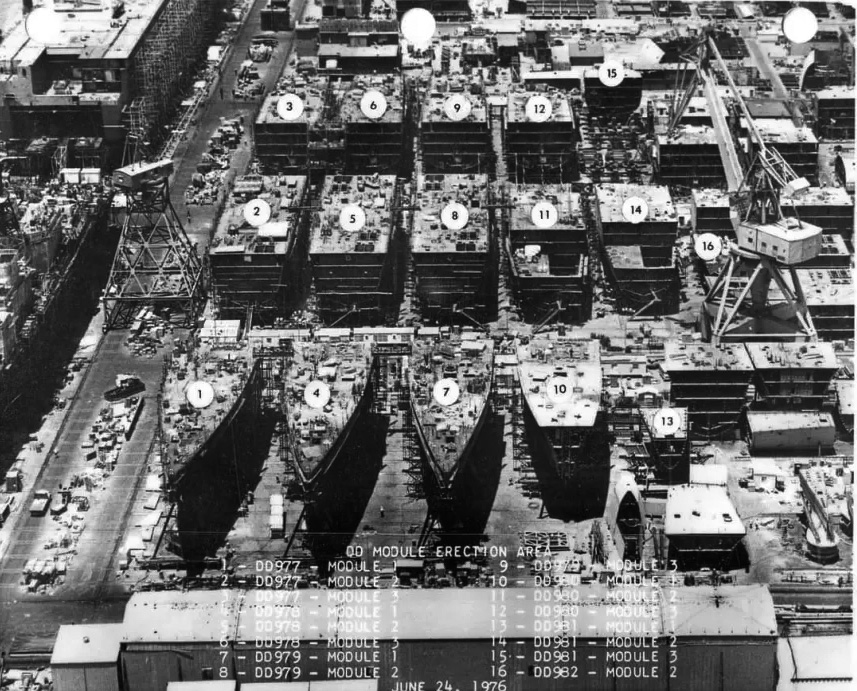
Modular contruction at Ingalls
The final design as approved was was to conduct to mass construction inside a single yard, Litton Ingalls Shipbuilding in Pascagoula, Mississippi. Laid down of the first batch started in 1972 and commissions echeloned between late 1975 and 1980. USS Hayler was commissioned in 1983. Due to their appearance they soon earned the nickname of “Spru-cans”.
This was considerable as they were the first US Navy class powered with gas turbines, former marine versions of jet aircraft engines with reversible-pitch propellers and screws rotated in the opposite direction from other twin-screw ships. The crew was about the same as an Adams between 300 and 400 officers and ratings, and comfort and habitability considered in the design, and in the 1990s, they even started to be retrofitted to provide separate quarters for female personnel. Being much roomier they enabled way more spacious living quarters for the crews, in stark contrast to the previous destroyers, always on the cramped side. Fact is, they were even considered like the “gold platters” in the old days when the 1934 Farraguts entered service compared to the WWI era “flush deckers”.
The acquisition under the DX program and attribution to a single shipyard for the production contract (and 30 ships!) was a completely new (and risky) policy based on “the Total Package Procurement” concept issued by Robert McNamara and the “Wiz Kids” of his department. This was really to take all advantages mass construction, with every parts sub-contracted coming into a single place. This ensire better control of these elements when received, and standardized integration, as well as just better standardization across the board, down to the minor details.
Not only that, but the yard’s sole responsibility of the class also extended to maintenance, repairs and refits, as well as major overhauls and upgrades over their service yards.
The “complete package” indeed.
This did not however went well with the “old guard” of the Congress however. Indeed, a new class was usually spread heavenly among yards located in the congressmen’ circumscriptions, ensuring the preservation of jobs (and votes). It was alleviated by the argument that at least a wide array of state-wide, coast-to-coast ubcontractors will still reap the fruit of the new order, the chosen yard being only the “final assembler”.
The selection process was also criticized at the time to be “notable for its political influence and changing rules”. The entire contract being awarded to Lytton Ingalls Shipyards of Pascagoula in Mississippi on 23 June 1970 was a first in the USN by its scale, and also the number of innovations brought into this new class. An extremely risky move indeed by the number of novelties in this procurement and many in the Navy and at Washington predicted a disaster.
And as predicted, despite is optimism of the yard to reap the benefits of the “quarter century contract”, Labor and technical problems soon caused cost overruns and construction delays. In fact, USS Haler ordered on 29 September 1979, originally planned as a DDH (Destroyer, Helicopter) design, with a modified deck to carry far more helicopters and somewhat influenced by the JMSDF’ own destroyer concepts.
Ultimately, this DDH program was terminated (see below) and DD-963 entered service in its original form as well as an additional four ships originally built for the Iranian Navy and fitted with the Mark 26/Standard missile system, and after the revolution became the “Kidd class” in thz USN (see below). They were far more advanced general-purpose ships and way better than the Spruance, but continuting production of that class was denied. As well as rebuilding all Spruance ships to this standard due to the cost being too high already. The Ticonderoga-class cruisers were in fact, “Kidd” under steroids, initially planned as DDG-47-class destroyers but redesignated as “cruisers” in 1980 because of their more complete armament and Aegis combat system as well as integrated flagship facilities. And these 27 ships were distributed this time between Ingalls and Bath Iron works. Lessons were learned.
Design of the class
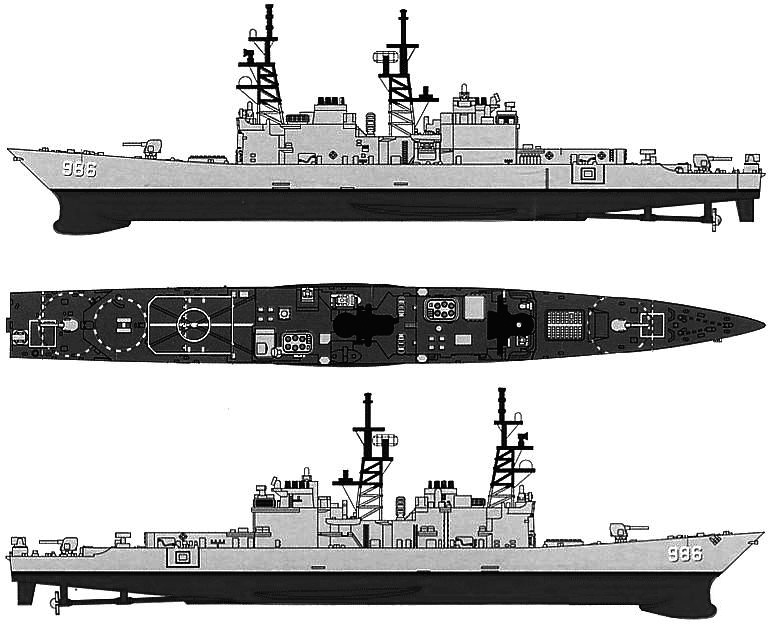
Final design, DD-986 Hill
Hull and general design
The final ship was a leap forward in terms of dimensions as said above: A displacement of 8,040 (long) tons fully loaded, and after upgrades in the 1980s they even reached approx. 9,200 tons fully loaded, and circa 6,156 tons light. They reached light cruiser tonnage, to be compared to the last Charles F. Adams built before (3,277 tons standard, 4,526 full load), so twice as much.
The ship’s Length was 529 ft (161 m) at the waterline for 563 ft (172 m) overall for a beam of 55 ft (16.8 m), so making for a 10.5 ratio, quite favourable to speed. Mean Draft was 29 ft (8.8 m).
So in dimensions, once again the increase was spectacular from 133 x 14 m to 171 x 17 m.
But the hull was also radically new. Instead of the classic flush deck style adopted from the WW2 fletcher class onwards, the new hull not only returned to a stepped design (with a lower, short aft section) and had much fuller forms. The tall freeboard helped considerably their seakeeping, unlike the flush-deck ships, to meet the objective of keeping full speed even in heavy weather. The roomier hull also helped to install a very large and complex CODOG system in order to push performances much further compared to the Adams.
A high degree of automation led to have only a crew of 24 officers and 302 rating originally, benefiting from an unparalleled Comfort and habitability introducing amenities such as a lounge, an ATM machine, a gymnasium, a class room, and a general store (internal supermarket for the crew). Habitability benefited to new living spaces divided by partitions ensuring single, permanent and private berthing spaces with curtains, each room having no more than six men each and recreational area as well as more numerous an accessible sanitary spaces. However the crew varied in time with additional armament, jumping up to 322 at the end of their career, as well as the installation of separate spaces for women.
Protection
Originally none. The “spru-cans” were originally intended to displace under 7,000 tons full load, but from DD 997, additional Kevlar armor was installed around the CiC and other places like the ammo storage under the main guns, so she displaced 8,250 tons full load when completed. Kevlar plastic armor was added later to all units inside vital spaces, starting with the four planned FY 81 with the entire class armoured by 1986. The superstructure was left in aluminum and welded to the hull via bimetallic strips, and so was sensitive to fire, but halon sprinklers (like in tanks) was installed all around. Plus the ships were made NBC with total sealing possible, like the Nimitz class carriers. There were pumps that can washover their decks in case of a fallout.
In addition, the tomahawk and harpoon canister were also armoured.
Powerplant
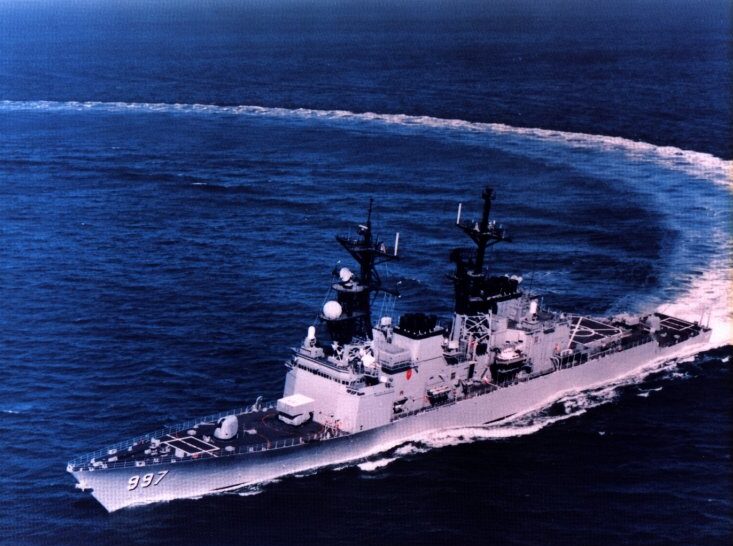
Hard rudder sea trials tests, USS Hayler.
These were the first class in the US Navy to have gas turbine power, a true revolution. The US were catching up with Europe which already tried this system since more than a decade, and the Soviet Union was just introducing it for their Kara class, contemporary to the Spruance. Each destroyer has four General Electric LM-2500 engines, basically marine shaft power versions of the TF39 turbofan used on the DC-10 and C-5A aircraft. These were rated at 20,000 shaft horsepower each while the four main recalled modern jet aircraft. For this, they were rated for “well beyond 30 knots” which was shown on trials (classified), the number 30 being kept for naval standard. Most authors specifies 32.5 ot 33 kts as “top speed”. The overall output was 86,000 shp.
Full speed in addition could be reached from 0 to 12 knots in just 53 seconds, and two minutes or so to 30 knots and more. They were called the “navy’s muscle cars”. This propulsion machinery, another innovation, was placed under the control of a single operator located in the central control station (CCS) thanks to heavy automation. Either of the three gas turbine generators was rated to 2,000 kilowatts and there were two engines per shaft while each was driven by locked train with double reduction and double helical reduction gears, enabled also to installed twin controllable-reversible pitch propellers allowing very quick turns and braking, bringing the ships to a full stop in record time. These propellers had a diameter of 15 ft (4.5 m) with 168 rpm revolutions at 30 knots.
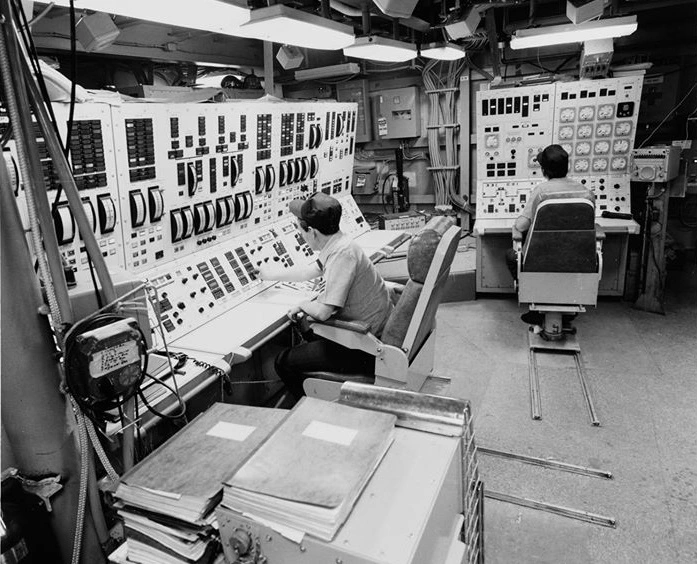
The machinery central operation center dueing 1975 trials. (US official photo)
To add to the benefits of this machinery, apart the turbine-like hissing sound, greatly attenuated, made the propulsion machinery very quiet, essential for ASW ships. Engineers managed to add the Prairie/Masker hull system (Radiated noise reduction system fitted also to the Oliver Hazard Perry-class frigates, Arleigh Burke-class destroyers, Ticonderoga-class cruisers) and a propeller bubbler system to reach this.
Endurance could be enganced by using a single shaft, with automatic compensating angle braking on the rudders for cruising. Between overhauls the LM-2500 gas turbines could thanks to this, be used continuously for 9,000 hours with only basic maintenance. DD 963 introduced electric heating while DD 997 introduced the Litton automated engine-control system. All previous destroyers had a waste-heat boilers which required heavy maintenance problems and proved problematic all along their career. But overall, they were rated for a range of 6,000 nautical miles at 20 knots or way more using a single shaft at cruising speed, while the gas turbine oil storage was 1,650t in normal conditions.
Armament
The Spruance-class destroyers had a very complex missile loadout history for an ASW ship, with numerous changes and variations poorly documented. One great hope that the expected modularity of the roomy hull and superstructures would allow some easy upgrades. This was not the case, explaiçning in part the 20-years service of these “cursed ships”.
The Original Armament
When entering service in 1975, USS Spruance only had in addition to her two single guns (like the Adams class), a single eight-cell ASROC launcher forward and another eight-cell Sea Sparrow aft. This was the same as a Knox-class frigates and when in service, immediately rise an outcry as they were woefully underarmed for their size and operating cost. It was just hoped that thry could receive additional systems in the future. However this weakness was only apparent as unlike the Knox, they carried 16 reloads for each systems wether ASROC or Sea Sparrow, a greater capacity than any previous missile-armed destroyer. The builder also was only instructed to install initially the ASROC system, that’s the Navy that installed the Sea Sparrow post-completion, and all pre-commissioned ships were indeed only armed by the ASROC as “pure” ASW vessels. Besides, their larger helicopter capacity, the best sub-trackers in the inventory, was also a plus.
So the initial provisions of vectors in 1975 was 24 Sea Sparrows and 24 ASROC instead of 16 and 16 for the Knox.
RUR-5 ASROC
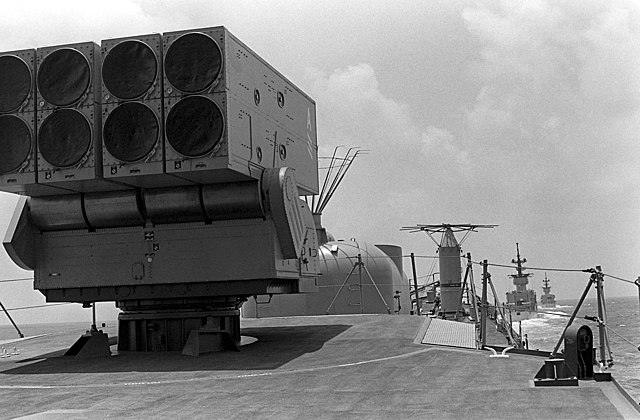
MK-112 “Matchbox” launcher. Rocket propelled acoustic homing torpedo (or alt W44 Nuclear Depth Bomb). Mark 46 torpedo: 96.8 pounds (43.9 kg) PBXN-103 HE payload, parachute dropped for low speed, less noisy entry.
Missile Range: 22 km, inertial guidance, 488 kg vector.
Torpedo Range: Two-speed, reciprocating external combustion (Otto fuel II) 12,000 yd (11,000 m)
Maximum depth Mk 46: 1,200 ft (370 m)
Maximum speed: 40 knots (74 km/h; 46 mph)
Guidance system: Active or passive/active acoustic homing
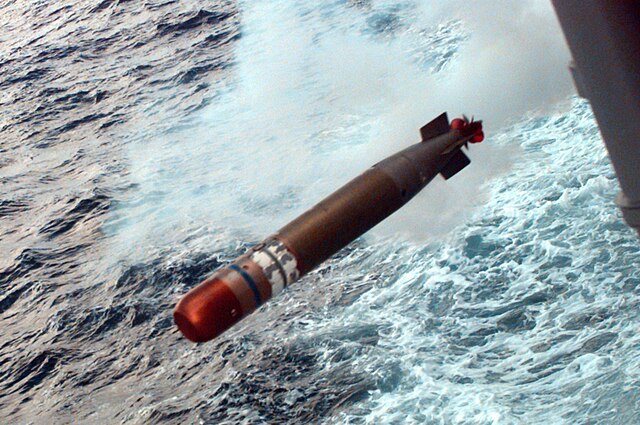
Mark 46 tube-launched by DD-980 USS Moosbrugger of the Spruance class.
RM-7 Sea Sparrow
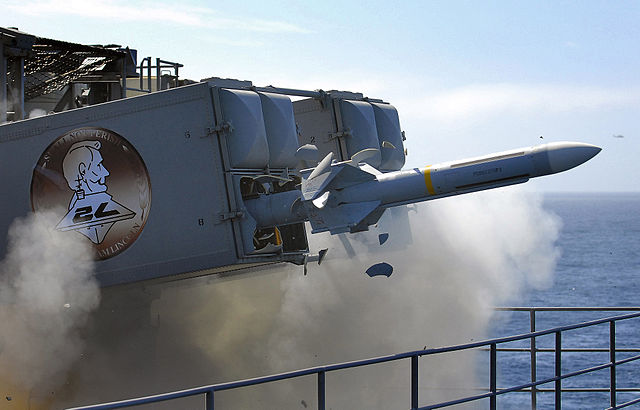
Installed after completion on the lower aft deck, thes were a mainstay of frigates as primary short range missile defense system.
Missile weight 510 lb (230 kg), 12 ft (3.7 m) long by 8 in (20 cm) diameter, 3 ft 4 in (1.02 m) wingspan.
Carries an annular blast fragmentation warhead, 90 lb (41 kg) with Proximity fuzed and expanding rod (27 ft (8.2 m) kill radius)
Engine: Hercules MK-58 solid-propellant rocket motor for 10 nmi (19 km) range at 4,256 km/h (2,645 mph)
Guidance: Semi-active radar homing
5-in/54 Mk45 guns
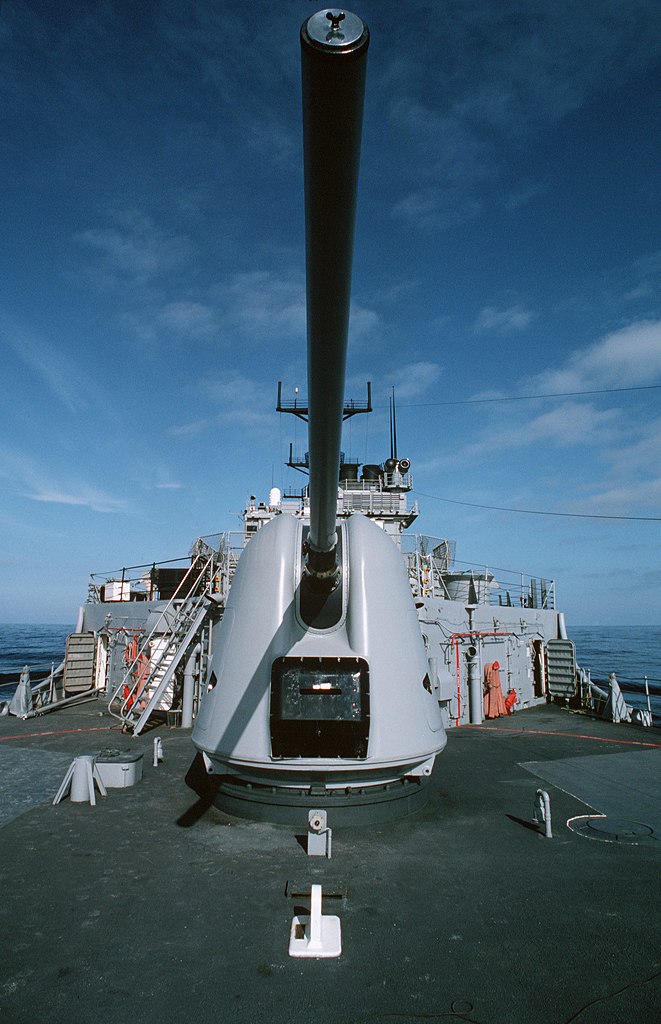
5-in/54 mk.45 aft of USS-Leftwich, DD-984.
Design from 1968, introduced in 1971 as the Spruance entered service. Fully automated instead of the previous weapon system, so it was much smaller and lighter but fired faster and more accurately.
Mass 21,691 kg (47,820.5 lb) for 8.992 m (29 ft 6.0 in) long.
Shell 127 x 835mm (54 caliber) .R 31.75 kg (70.0 lb)
Elevation −15° to +65° at 20°/s, traverse ±170° from centerline at 30°/s
Rate of fire: 16–20 rounds per minute, automatic 2,500 ft/s (760 m/s)
Effective range: 13 nmi (24.1 km)
Appearance

Spruance class DDs old author’s rendition
⚙ specifications (1972) |
|
| Displacement | 5,830t/7,800t FL, 8,040t (long) full load |
| Dimensions | 563 x 55 x 29 ft (171 x 16.8 x 8.8 m) |
| Propulsion | 2 shafts, 4 CODOG GE LM2500 Gas Turbines 80,000 hp (60 MW) |
| Speed | 32.5 knots (60.2 km/h; 37.4 mph) |
| Range | 6,000 nm/20 kts, 3,300 nm/30 kts |
| Armament | 2 × 5-in/54 Mk 45, 1×8 ASROC, 1× 8 Sea Sparrow Mk 29, 2×3 Mark 32 TTs |
| Sensors | Radars SPS-40 SPS-55, SPG-60 FCS, sonars SPQ-9, SPG-06, SQS-33, see notes |
| Air group | 2× Sikorsky SH-60 Seahawk LAMPS III helicopters |
| Crew | 19-315 1975 |
Upgrades
In short:
-Two Quadruple Harpoon missile canisters (all)
-Two 20 mm Phalanx CIWS Mark 15 guns (all)
-Two Quadruple ABL Mark 143 Tomahawk missile launchers (on 7 ships)
-One 61-cell Mark 41 VLS launcher for Tomahawk/ASROC missiles in place of the 8-cell ASROC launcher (24 ships).
-One 21-cell Rolling Airframe Missile launcher on some ships
Arrival of the Harpoon (1978)
The first upgrade was the “easy addition” of eight Harpoon antiship missiles in canister launchers amidships for anti-ship offensive capability. The first having these was apparently in 1978 USS Hewitt (DD-966) and the process was over by 1985.
Arrival of the Tomahawk (1980)
At the same time the even more capable Tomahawk alro arrived in canisters, and the navy tried to fit them on any platform. The large Spruance-class were priramy candidated for the upgrade, starting in 1980 with USS Merrill (DD-967), making the first surface launch for the USN. Initially a pair of four-vector canister Launchers, armoured (ABL) one on each side of the ASROC launcher. Merrill only had the port one mounted during trials, later another was added. 7 destroyers were modified circa 1986. It was alternative to harpoons on Merrill.
This early Tomahawk was a conventional or nuclear antiship missile, so did the ASROCs as an option, and all Spruance were supposed to carry them for some missions at all times.
Arrival of the Mk 41 VLS (1986)
The canisters allowed the Tomahawk tto be quickly operated, but the systems were heavy (armoured), limiting the number of vectors aboard. The ideal solution appeared to be a VLS, in that case, the Mk 41, a new launcher first installed aboard USS Spruance in 1986. This was a 61-cell module, with 3 cells dedicated to the reloading crane; It replaced the ASROC launcher and its magazine forward and this has been only possible because of the modularity of internals, planned for a future DDG variant.
This successful midufication greatly enhance firepower as the ships were now able to perform saturation fire, and twentyfour of the Spruance-class received this upgrade, modified ending in the late 1990s, shortly before decommission. This VLS installation enabled both antiship and land attack capabilities, while sacrificing the ASROC which had been the bedrock of its original ASW vocation Development of a Vertically Launched ASROC (VLA) started by 1983, but delays due to the promising (and later candelled) Sea Lance missile had it only available in the 1990s, too late for the Spruance class.
Vector changes, early 1990s
In the early 1990’s post Cold War budget cuts drastically reduced the Spruance’s upgrade possibilities. Operational requirements also changed, as the bulk of the former Soviet submarine fleet was rotting in ports. The nuclear-capable Tomahawks were retired and replaced by conventional land attack weapons for ground support, completely changing the Spruance-class nature.
Arrival of the VLA (1993)
From 1993, VLS ships were converted to the new VLA (ASROC) to have their ASW capability restored. But the conversionw as only made on the limited number of ships as thee systems were already shared with the Ticonderoga-class cruisers, and new Arleigh Burke-class destroyers. It seems those equipped only had four missile. The typical provision for these was 24 Sea Sparrow, 57 TLAM, 8 Harpoon and 4 VLA.
Final changes (late 1990s)
Also in the mid-1990s the now obsolete ASROC was withdrawn and 7 of these destroyers had neither the VLS upgrade or ASEROC, leaving them without ASW weapon but their helicopters. In place opf the ASROC box launcher, the magazine was plated over. USS Merrill by 1993 for example only had 24 Sea Sparrow, 8 TLAM and 8 Harpoon. This was far less than a similar size “Tico” or a Burke class DD.
Harry W Hill (DD-986) was even left withits eight Harpoon canisters and 24 Sea Sparrow, so essentially less armed than a frigate.
The final upgrade from 1997-1999 saw ten VLS-equipped Spruance receving the new 21-round Rolling Airframe Missile (RAM) launcher on the fantail in lieu of the sea sparrow. It had less range than the latter but at least had semi-active radar guidance, passive-homing to engage multiple targets simultaneously. It is also capable of intecepting sea-skimming antiship missiles unlike the sea sparrow. This upgraded started in 1997 on USS Oldendorf (DD-972), the last being added by 2003.
However despite all these upgrade, the Spruance class remained fa rmore vulnerable to air and missile attack and between their large size and accompanying operating costs they were doomed in a post-cold war budget-stripped USN. Decommission started in 1998 and went up to 2005 so even less than 20 years of service. Some Spruance which received the last upgrade only kept it for two years.
Communication & Tactical Information Management
The radio equipment aboard the ship enables SPRUANCE to send and receive messages from any part of the world. Operating 24 hours a day, speed and accuracy have been refined to an art by SPRUANCE radiomen. Communicating within a battle group for tactical purposes is accomplished through the Naval Tactical Data Systems (NTDS). All combat detection, tracking and fire control systems are integrated through the ship’s digital Naval Tactical Data System Computer, providing the ships with fast and accurate processing of tactical information. Using high speed computer-to-computer data links, NTDS welds together the processing capabilities and sensors (radars, SONAR, etc.) of each of the individual units in company, presenting a complete tactical picture.
The SPS-55 surface-search radar antenna has been moved to a new, higher platform on the foremast in order to accommodate the radome housing the antenna for the SQQ-28 LAMPS-III helicopter datalink. A small navigational radar set (usually of the Raytheon SPS-64 series) is now mounted above the pilothouse.
DD 971 carried the prototype USC-38(V) EHF SATCOM installation (FLTSAT-7), and many of the class have now had the WSC-6 SHF SATCOM system installed. The Hughes Mk 23 TAS (Target Acquisition System), which uses a high-rpm radar, has been mounted on all units but DD 986 on an aft-projecting platform on the mainmast to detect low-flying, high-speed missiles and aircraft.
All ships have the NATO Link 11 data-sharing system. USW is handled by a Mk 116 fire-control system. The Mk 91 Mod 0 fire-control system for Sea Sparrow uses a single radar director.
A total of 12 ships of the class (two conversions funded under FY 02, three each under FY 03 and FY 04, and four under FY 05) are to be given CEC (Cooperative Engagement Capability) modifications to permit Standard SM-2 MR missiles to be launched from the vertical launch cells, with the missiles to be controlled by another ship.
In addition to the Cooperative OUTBOARD Logistics Update (COBLU) Phase I Signals Exploitation System, the ships have a SLQ-32 electronic warfare sensor which provides tactical detection and analysis of enemy electronic emissions. Early units were given the WLR-1 EW system as an interim installation until SLQ-32(V)2 was available; at least two ships (DD 971, 975) carried both. In 1987, it was announced that the EW suite would be upgraded to SLQ-32(V)3 in all, but that decision was superseded by installation of the Raytheon Short Stop active jammer, upgrading the EW system to SLQ-32(V)5. However, many ships still do not have the active capability. In those that have had Mk 15 CIWS Maintenance Enclosures added, the portside SLQ-32(V)5 antenna array has been moved aft to beneath the CIWS mounting.
The AN/SYQ-17 RAIDS (Rapid Antiship missile Integrated Defense System) was installed in the entire class during mid-1990s overhauls; the electronic system serves as a rule-based planning aid to coordinate the use of the ships’ defensive systems and uses target input from the Phalanx CIWS radars. They also have four Super Rapid Blooming Offboard Chaff (SRBOC) Launchers and four SLQ-49 decoy launchers to confuse and decoy enemy homing missiles. During a 1994-95 modernization refit, DD 997 became the first ship to carry the Westinghouse MSTRAP (Multi-Sensor Torpedo Recognition and Alertment Processor). DD 985 began trials with the Remote Minehunting Operational Prototype (RMOP) (V)2 during 1996, using a winch and recovery system mounted on the portside boat deck.
ASuW protecton bubble
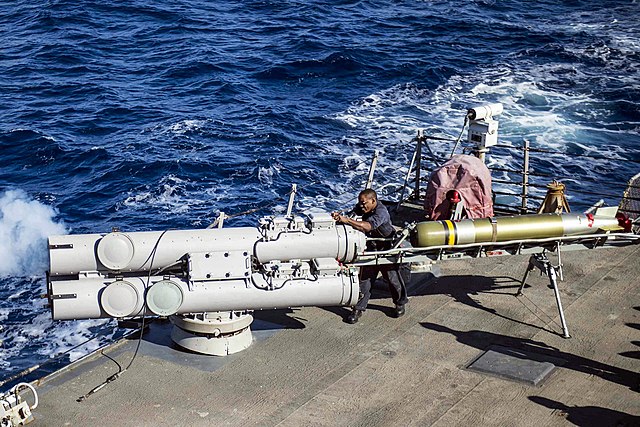
Mark 32 TT bank, firing the Mark 46 acoustic torpedo. It carried a PBXN-103 high explosive 96.8 lb (43.9 kg) Warhead at 12,000 yd (11,000 m) and down to 1,200 ft (370 m) at up to 40 kn (74 km/h; 46 mph).
Composition: The “trident”
Anti-submarine warfare was the bedrock of the class, and this included a sonar suite with the most advanced underwater detection/fire control system ever developed by any USN ship. The base of the armament relied on the always trusted two triple Mk 32 torpedo tubes bank, located amidship either side and ASROC. The other main advantge were the two SH-60B LAMPS Mk III helicopters aft acting as an extension of the whole ASW suite.
The SQS-53 hull-mounted active sonar doubled by the SQR-19 tactical towed passive acoustic array were indeed a serious asset making the Spruance the best ASW escorts ever designed so far indeed.
DD 980 by fall 1985 started to test the new SQQ-89 sonar system, which incorporated the SQS-53B and later SQS-53C active bow sonar plus SQR-19 passive TACTASS. Later in life they swapped to the SQQ-89(V)8 sonar suite and Lockheed Martin SQS-53D sonar as well as the SQR-19 towed array plus the SQQ-28 helicopter datalink, Mk 116 Mod.
5 UBFCS, and SIMAS processing system to stay relevant in the 1990s. In addition to the SLQ-17 sonar signal processor and the SRQ-4 helicopter datalink receiver the helocopters also operated the SQQ-28 sonobuoy analyzer and UYQ-25 acoustic range predictor as well as the UYS-1 acoustic spectrum analyzer in a mobile way. When equipped with the VLA ASROC this was assorted with the Mk 116 Mod 5 or Mod 8 underwater fire-control systems. The seven ships lacking ASROC had the Mk 116 Mod 9 FCS system.
Capabilities
The ships were able to located submarines at considerable ranges and depths. The hull SONAR emitted a very powerful sound wave reflected by the submarine and bouncing back range and bearing data until its position was determined. It cold be either by the hull sonar or by its SH-60B Helicopters, and computers pass the retreated information to the ASROC and helicopter (the second one could be used in a hunter-killer fashion). After the helcopter bubble (see later) went the ASROC releasing after a predetermined time, its homing torpedo on station, the same Mark 46 with great range and speed, homing on the already located target, until destroyed.
Closer in engagement, the torpedo launchers were used, with six ready, and quick reload. Indie the rload magazine the Mark 46 could be repared with optional warheads. The SPRUANCE class were also equipped with a decoy launcher at the stern to divert incoming torpedoes herself. She also had the expendable bathythermograph (XBT) to get the most accurate and updated data on sea temperature at varying depths, crossing and correcting SONAR data and having an impact on its waves bent by layers of warmer and cooler water.
The AN/SQR-19 The AN/SQR-19 Tactical Towed Array SONAR (TACTAS) id the main passive sonar, very accurate and long range, and preferred method over the active sonar, not environment friendly to say the least due to the power of the sound waves. The passive became in the 1990s the main detection system, used at all times, comprising a serie of acoustic modules towed after a long cable out of the stern, as far as possible to avoid ship’s interferences. Its Hoist Room was located under the fantail between the cable and array and display consoles grouped in the main SONAR Control room.
Both the AN/SQQ-89 and AN/SQQ-89 SONAR were designed to incorporate several semi-independent or ported subsystems:
-AN/SQS-53B Hull-Mounted SONAR
-AN/SQS-19 Towed Array
-LAMPS MK III Sonobuoys
-MK 116 MOD 6 Underwater Fire Control System (UFCS).
Combining three SONAR systems and modern fire control system into a single control space allowed a SPRUANCE class to cross all data together in a smart way.
Helicopters
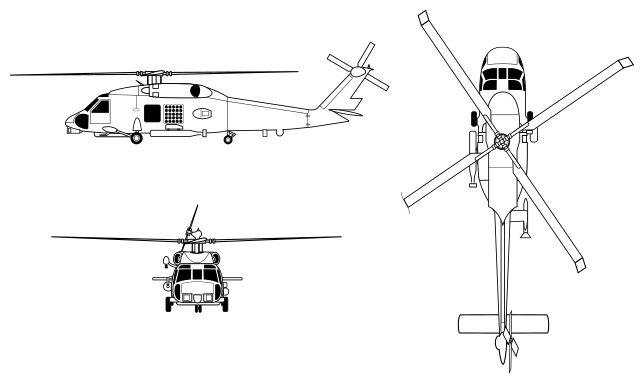
SH60B: Crew: 3–4, 5 passengers in cabin in transport mode. Slung load of 6,000 lb (2,700 kg), internal load of 4,100 lb (1,900 kg) and total 6,684 lb (3,032 kg) payload
With its max takeoff weight of 23,000 lb (10,433 kg), powered by two GE T700-GE-401C turboshaft engines rated for 1,890 shp (1,410 kW) they can reach 146 kn (168 mph, 270 km/h) over 450 nmi (520 mi, 830 km), well beyond the Spruance’s own sonar range.
Main advantage of the Spruance class, justifying the large hull: A pair of SH-60B HELICOPTER and their hangar for housing and maintenance, as the “Light Airborne Multi-Purpose Systems” or LAMPS MK III. The SH-60B is a twin-engine helicopter, with a crew of two pilots and single sensor operator/crewman, operating the sonobuoys and tracking targets. The ASW SH-60B Seahawk could carry xx sonobuoy and has the suite to receive the data and its interpretation system, as well as the Magnetic Anomaly Detection (MAD) gear, threat detection/display equipment. The helicopter could also ebe used for direct attack, carrying two Mark 46 ASW torpedoes, same model as those operated on the ship. LAMPS MK III could also perform liaison/medevac evacuations, SAR and gunfire spotting as well as over-the-horizon targeting and datalink for long range missiles such as the Harpoon. The flight deck was later modified to incorporate the Recovery Assist Securing and Transversing (RAST) System allowing safer flight operations in heavy weather.
On 15 ships, this flight deck has been widened, flush with the starboard side for the SH-60B LAMPS III plus dual RAST haul-down and deck traversing equipment. The Spruance were also operating the LAMPS-I SH-2F Sea Sprite helicopters until 1994. Torpedo magazines for the Mark 46 also comprised the Penguin Mk 2 Mod 7 antiship missiles for the LAMPS-III, on DD 979 from 1994.
Anti-Air protection bubble
The Air defense capability of the Spruance class was at first a NATO Sea Sparrow SAM complemented by two 20mm Phalanx Block 0 or 1 CIWS (Close-ln-Weapons Systems) to deal mostly with incoming missiles, and SLQ-32 Electronic Counter Measures system. By 1994, the MK-23 target acquisition system was integrated, served by the SPS-40 2D air search radar and SLQ-32 electronic support system. The SWY-1 integrator interfaced the MK-23 target acquisition radar with the Sea Sparrow and CIWS over incoming targets.
Since 1994, the SWY-3 integrator was coupled with the RAIDS and RAM Block 0 launcher, installed aft. In 1998, the Navy estimated the air defence to be moderately low and justified retirement based on near-term and low relative to mid-term threat requirements. By 30 September 1999, only 7 destroyer had the RAM. The navy expected an upgrade with NULKA for all, and RAM Block 1 to three ships but this was not voted.
The DD-963 sub-class ended with the most capable air self defense system between the antimissile detection system Mk 23 TAS/NSSMS FCR, with moderate field-of-fire blockage zones at the bow, but the missile range stayed short while the air search radar was a 2D. After RAM was canceled, only the Mk 15 CIWS mounts were upgraded to Block I and located in maintenance enclosures with the aft mount raised atop a new deckhouse. This made the Spruance dependent of the presence of a Ticonderoga for air defence.
General assessment
The underarmed, but innovative “love boats”
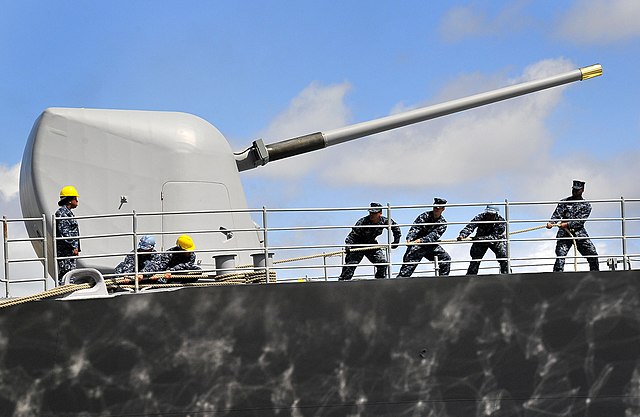
SAN DIEGO (April 12, 2010) Sailors aboard the guided-missile cruiser USS Bunker Hill (CG 52) secure mooring lines from the pier after returning home from a three-month deployment. Bunker Hill conducted humanitarian and disaster relief operations in Haiti during Operation Unified Response and held partnership exercises with Latin American countries as part of Southern Seas 2010. (U.S. Navy photo by Mass Communication Specialist 2nd Class Daniel Barker/Released). Despite being automatic, the new guns were no less impressive in size, as shown by the personal in front here.
The Spruance class destroyers were controversial: In more ways than one. The production of 30 ships by a single yard, Litton Industries, Ingalls Shipbuilding Division at Pascagoula, Mississippi, this was already a risk. This was later confirmed by personnel and component problems. Delays accumulated, but every year five destroyers were launched, a feat for ships of that size. The Navy did not liked them particuarly at first: They were considered too large, weak (so much they were called the “Love Boats” since they were of the size of WWII light cruisers (8000-tons), yet only carried a pair of 5-inch guns) and a poor replacement for the FRAM, albeit this was superficial: Albeit funded by the bankrupt Carter aministration, their armament suite was still superior to the FRAM notably by the number of vectors, an having two large helicopters well service was definitely a great advantage.
It was thought by many in the Navy that the Knox Class Frigates who would have provided an interim before the construction of improved ships. The failure of the Typhoon system planned FY 1963 ruined all these plans. Later it was planned to integrate them in a plan to have escort aircraft carriers, with six ship in escort, three in their ASW configuration and three converted as SAM ship, plus the commonality of ASW systems between ships as a development guide. Mc Namara insisted over a single contractor for a ship which later could be declined from a single ASW or SAM.
Mass production savings, standardized hulls meant the ship could be later reconfigured for example if the ASW threat was more present in the future than the aerial one and vice versa. But with the budget cuts post-1990, many of the additional embedded systems were never installed and the large superstructures left containing large empty spaces. The large size meant a large machinery to maintain 30 knots in bad weather with sufficient autonomy, meaning higher costs. Plans to have these ships converted as helicopter destroyers were also envisioned (see below) as well as selling them to allied navies in their upgraded form. First was Iran, next ROCS, but this soon petered out amidst policy changes and international situation.
By 1978 already it was also planned to enhance their land-attack capabilities by the installation of a brand new 8-in/55 gun to cover amphibious operations, but this program was later cancelled. The modular structure still allowed for modernization but the ships were doomed by changing priorities and reduced budgets. These waves of upgrades never concerned the entirety of the class, many of which were even further disarmed at the end of their career, making them an even less interesting proposition compared to the “Tico” and new Burke classes.
However the ship had far more reedeming qualities. Yes, they were perceived as underarmed for their size, but they bourght more advancements to USN Destroyers than any previous class, and inaugurated a lot of “firsts” while demonstrating amazing capabilities as flagships and collectioning awards throughout their short career. That’s the main point, since they were nearly all sunk as targets after 18-25 years of service, it seems to the general public they were “failed” boats. After all, the same-hull “Tico” served for a decade more. The general public is perhaps unaware of theior AEGIS suite and more rounded, beefier armament overall.
Truth is the “spru-cans” did their job as intended, they started as state of the art ASW destroyers and ended as highly versatile multi-mission destroyers. Each was capable of operating independently or in company with Amphibious or Carrier Task Forces. Main mission was to operate offensively in a Strike Warfare or Anti-Submarine Warfare (ASW) role while their Tomahawk Weapons Systems provided them long range capability for tactical strike operations. Their passive ASW sensor AN/SQR-19 Tactical Towed Array Sonar (TACTAS) was innovative and really powerful for the time, in fact it was the best of the era.
Working together with the Mk 116 Underwater Fire Control System, this combination remained for alt least 15 years the most advanced underwater detection and fire control systems ever developed. The Naval Tactical Data System (NTDS) as provided faster and more accurate processing of target information, although still not on par with AEGIS, this was a true revolution compared to the Adams. Integration later of digital gun fire control system in the NTDS provided quick reactio in shore bombardment but the gun could swap in a instant to Anti-Surface or Anti-Aircraft fire.
Their original 8-tube ASROC launchers were later upgraded with a sixty-one cell Mk 41 Vertical Launching System (VLS) capable of firing the Tomahawk Land Attack Missiles (TLAMs) and Anti-Submarine Rockets (ASROCs) as well, so adding a powerful anti-ground warfare capabilities to an already extended ASW one. The two Mk 45 light weight 5 inch guns as said above reached perfection (first introduced on these ships they became the new standard, ported notably on the Ticonderoga and Arleigh Burke classes. It was completed by the good old trusted two triple Mk 32 torpedo tubes.
But overall their greatest asset when in service in the 1980s were their extensive facilities for operating two LAMPS (Later LAMPS III) helicopters. She received the NATO Sea Sparrow Missile System, short range, but also the Harpoon Weapon System, medium range anti-ship asset, which was well proven. And against opposite missiles, two Mk 15 (PHALANX) 20 mm Close-In Weapons System and a robust EW suite, between SRBOC chaff, AN/SLQ-32 countermeasures set (among other systems) and if that went down to a hit, armored NATO Sea Sparrow and canisters for the harpoon and tomahawk as well as internal composite and kevlar plating around the internal Operating Central Control room.
Another point, not negligible for good morale and performances was Crew comfort. The ships being that roomy, habitability was worked out well to provide more intimacy, calm and ergonomics, and became integral part of the design. Berthing compartments were spacious, she had amenities absent from former destroyers (or any destroyer in the world at the time) like a crew’s gymnasium, improvised library, a shop and a more extensive medical facility. This was help by their boxy superstructures, they were large as a World War II cruiser.
At that stage also a high degree of automation allowed a crew of “only” 24 officers and 296 enlisted to operate her, something unheard of. For an Adams prior to decommission, this was 333.
This also enabled something unheard of for a cold war destroyer (although this was done in the 2000s), the “crew swap”. Called Operation “Sea Swap” this was an attempt to have any of these ships operational for 400 days continuous at sea. Crews needed rest, so they were exchanged from those of other destroyers after six months.
“Curse” of the Spruance, the abandoned class
The “spru-cans”, so named because of their aluminium, large box style structures, mostly empty for most of their career, but still they managed to be upgraded, and in the 1980s and 90s, increasingly armed, most swapping out their old ASROC for a 61-cell Mk41 VLS system as in the Ticonderoga class (but lacking the AEGIS) and all having their Harpoon SSMs, NATO Sea Sparrow SAM launcher, two 20mm CIWS R2D2 guns and for the last ones, a 21 cell RIM-116 RAM on their starboard fantail but they varied considerably in armament, some completely lacking their original ASW capabilities.
This made difficult to use them on a mission-based assignation, and they were usually relegated to second line duties, in a post-vietnam context. Instead of active wartime action, they were found themselves as the backbone of fleet operations in the ingrate last decade of the Cold War between Libya, Lebanon and the Persian Gulf, and war on drugs closer to home. Nothing to really shine in the news.
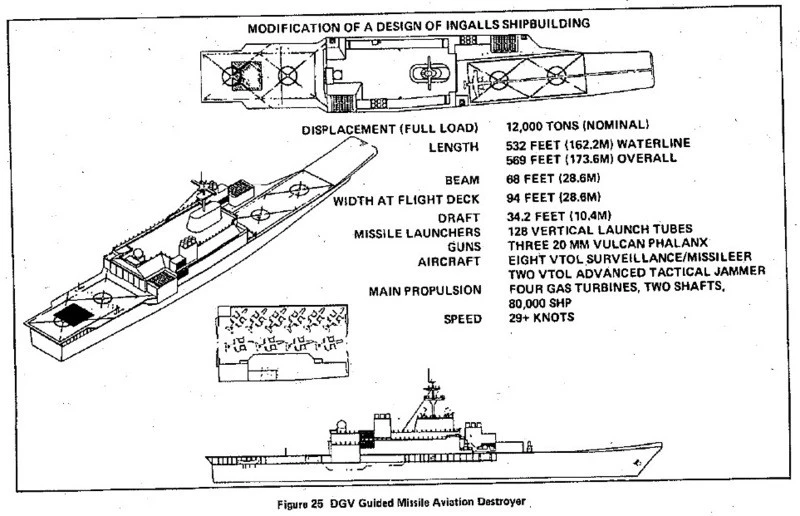
One proposal under the reagan administration, was to convert these ships as VTOL carriers
To add insult to injury, post-1990 context prevented any significant upgrades as they appeared infinitely less capable than the Ticonderoga, albeit having the same size, operating costs and near same crew. In the upgrade list, they came as an afterthought. Some in the navy hoped to save them from the scrapyard and proposed a useful conversion, still sticking to the old concept, almost resurrected under each administration and never carried out, of an escort carrier in case of war.
Many “aviation destroyer” variant proposals flourished, notably a “through deck destroyer” variant with ski jump and capable of operating as much as 10 VTOL aircraft, helped by the destroyer’s size and “long legs” (6000 nm at 20 knots) to operate independently of the battle group like WW1 hunter-killer groups (called the “guided missile aviation destroyer”), or doing flag-waving missions in foreign ports. But nothing came of it.
After all the 2000s decommissioned, the navy was lest with less “Ticos”, undergoing gradual retirement, and a fleet of standardize Burke that unlike the Spruances, lacked ASW, ASuW and land-attack capabilities. After all after being all retired, the Spruances retired from the fleet 1,494 Mk41 VLS cells (Tomahawk cruise missiles) 30 ASROCs, 62 5-inch guns, 62 CIWS guns, 249 Harpoon, 62 LAMPS helicopters, 249 Sea Sparrow, 210 RAM missiles, and 186 Mk32 ASW Torpedo tubes plus their sonars.
This was before the context changed again.
In the 2010s it was obvious that if the Russian Navy was only a shadown of a threat, but the rapid rise of the Chinese PLAN was undoubtely one to be seriously considered. The shift toward Asia had been abundantly commented and does not need extra exposure, as well as pdt. Trump wish to return to a “500-ship fleet”.
There, in a context where US shipyards are cash-stripped and even unable to adequately service existing ships, or taking more time to built new ones, and new frigates are on the way, the modular hulls of the 30 “spru-cans” are sorely missing to the Navy today. Notably given the fact the AEGIs had been considerably reduced in size and cost compared after 40 years of improvements.
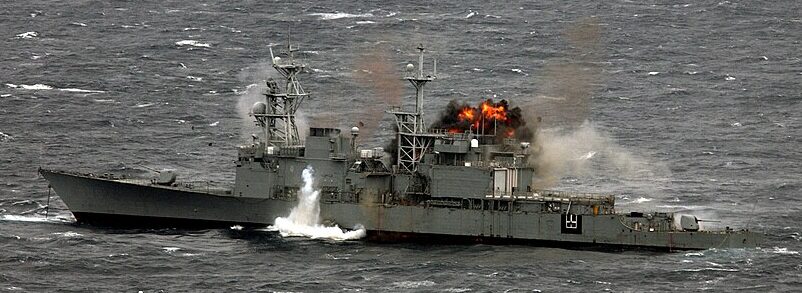
USS Hayler being disposed of by explosive tests at sea
Not only they were decommissioned, but they were rapidly disposed off, definitely instead of being just mothballed, pending future developments, like were WW1 and WW2 destroyers. Instead, they were systematically sunk in fleet training exercises, dismantled, or scrapped. They just deserved better. History will judge this “sabotage” of potential capabilities.
Like Europe, the US has been comfortably living under the “dividends of peace”, with only special or small expeditonary forces to lead asymetric warfare being considered worthwile. Fleets has been shrinking to the bone like if there was no tomorrow, and parliaments have little patience for “potential threats” in the distant future. 2023 had been a powerful wakeup call in this for the “free world”.
Kidd sub-class
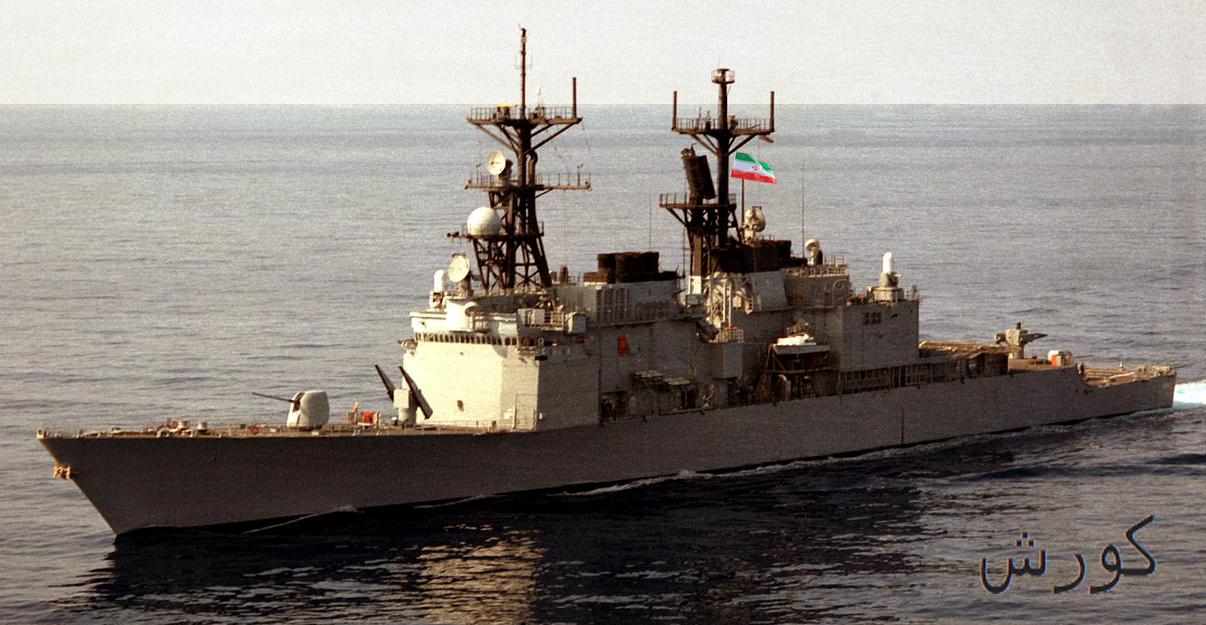
The “Kourosh class” initially planned to be delivered to the Shah in 1979, as they would appear with the national flag. These would have been the most formidable ships in the Persian Gulf and the whole middle east area if transferred in the early 1980s. All four were incorporated in the USN as the Kidd class, and transferred to Taiwan eventually in 2005-2006.
This Kidd class (Kidd, Callaghan, Scott, Chandler completed 1981-83) had a much superior SAM capability with two dual-SA-2 SAM launchers and 50 missiles in reserve, an AM ASROC x16 launcher, and SPS-48 radars. SPG-51 Another specific point was the addition of an armor that moved the weight to 9200 tons. The Spruance class, DDG-997 USS Hayler, was started on 20 October 1980, launched on 27 March In 1982, with an enlarged helicopter hangar, Kevlar armor, and an SPS-49 radar, the Reagan administration added six new buildings to its 1987 plan, which was built in 1983. The most promising Ticonderoga were then in operation. At the tests, the Kidd was able to reach 32 knots, the Kidd were only 29.
From 1981, the newly built ships received a Kevlar armor around most sensitive points, a modification which ended in 1986. This concerned the in-hull loading of the ASROC launcher, and Tomahawk launchers. From 1986, the buildings received modified Mk41 vertical tubes on the Mk26 base to launch Tomahawk missiles. 45 of this type and 16 ASROC ASW system. Later these launchers could also receive Sea Sparrow and SM-2 SAM missiles. However, it would have been necessary to modify the Mk86 firing system to control them, which was never done. These ships also eventually received the TAS Mk23 system coupled with the sonar SQQ-89, the towed SQR-19 and the SQS-53 bow. Some ships were modified for testing, such as the DDG-971 (Ram Launcher), DDG-976 (30 mm EX-83 Gatling), DD-997 (Mk86 modified to operate Sparrohawk missiles). In 1988-90 the Kidd were also modernized, including the SPS-48E and SPS-49 radar, receiving Phalanx missile guns and Harpoon systems.
Derivatives designs
Fire support Spruance
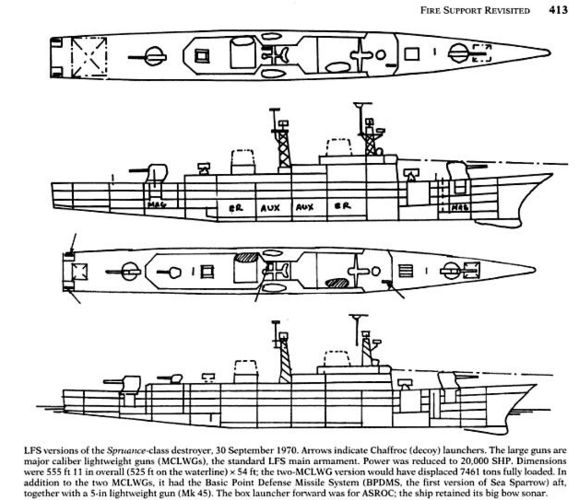
Another proposal (here extract from Friedman’s book via secret-project site). This proposal even precluded the final spruance class, dating back 30 September 1970. It argues for a derivative armed with two MCLWGs 8-in guns as standard LFS armament, power reduced to 20,000 shp as it was no longer question of chasing SSNs. This was the dedicated fire support version the navy wanted (after all, the Vietnam war still had a few years to go at the time). The hull was also reduced to 555 ft oa (170 m) for 7,460 tonnes FL. It also had the basic point defence system, and single 5-in lighweight gun as well as ASROC and probably TTs also. The sonar is also present to preserve AsuW capabilities. However the “major caliber lighweight gun system” or 8″/55 caliber Mark 71 gun tested in 1975-78 was never adopted.
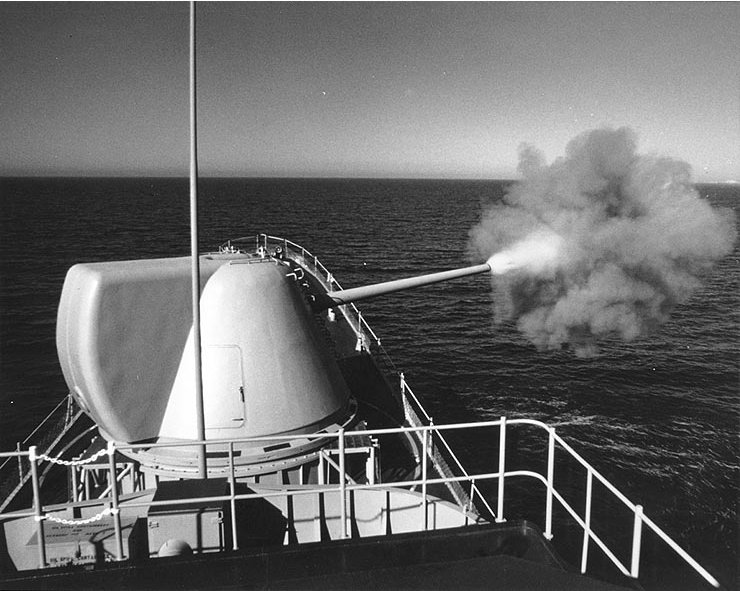
USS Hull (Charles F Adams) testing the turret prototype on 17 September 1975.
Aviation destroyer Spruances
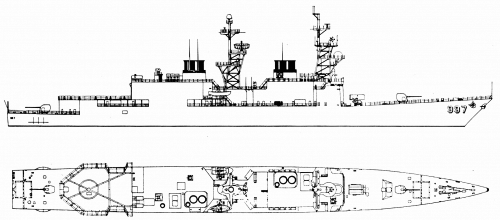
FY1978 saw Congress authorizing the production of two additional Spruance-class destroyers, but funded only one. This was a helicopter destroyer class (DDH), at not extra cost compared to a standard Spruance-class. Litton-Ingalls had the design work ready for DDH-997, the lead ship. It would have been given a moved back helicopter deck aft, and stretching the hangar, displacing the Sea Sparrow launcher to the top of the hangar. This was to operate either two SH-3 Sea Kings or four SH-60 Seahawk or SH-2 Seasprite helicopters. Nevertheless engineering work required was to be still substantial as a reference, the cost of the Kidd class was $110.8 million, and it it was justifiable for a whole serie, it became impossible to justify for a single ship. Thus, this was cancelled and USS Hayler (DD-997) ended as a regular Spruance.
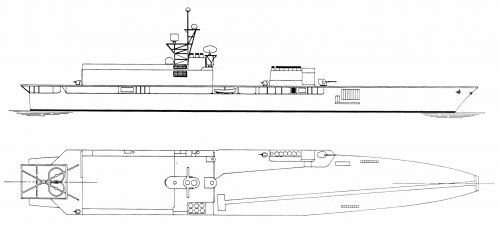
One of the earliest of the foll-up design proposals was worked out by Dean A Rains and Donald B Adams from Ingalls Shipbuilding Division, as the ‘flight deck DD 963‘. They looked like Croker’s ‘through-deck cruiser’ with a complete revision of design. Beam extended to 68ft, superstructure rearranged and a hangar above the main deck, flight deck forward of the hangar, ski-jump, landing deck abaft. This was a hybrid and small carrier.
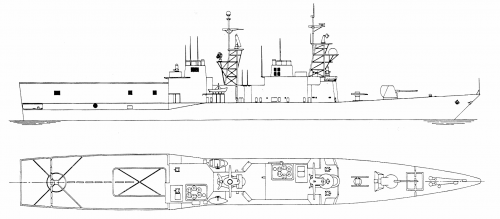
Another conversion proposal was worked out by Grumman/Santa Fe. It again looked like an hybrid and came as a ‘mid-life’ modernisation possibility of the Spruance class. It had a large hangar built onto the hull aft, and flight deck above to save space. It would rose to 9,000 ton but was not capable t operate up to eight helicopters; or four VTOL aircraft, and showed in fact a “in-house” design, the early(and cancelled) Grumman turbofan Model 698 gull-winged aircraft with swivelling engine nacelles.
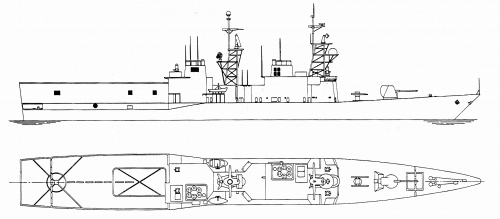
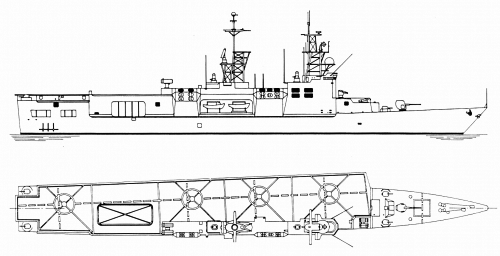
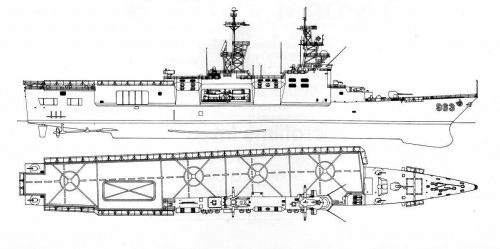
Probably one of the most dintinctive VTOL conversion, very alike the HMS Invincible in concept (contemporary) was geared for more extensive, unempeded STOL operations. This was was proposed by Commander Ronald J Ghiradella of the US Naval Reserve. Over the basic Spruance hull, lengthened to 606 ft and with gas turbine uptakes trunked to starboard, the new ships saw an island superstructure also to starboard, an space freed for a 470 ft flight deck, angling to port. Forward were relocated the 5in gun, Harpoon canisters. The 30mm CIWS are relocated on each quarter and the Basic Point Defense Missile System aft of the island. The lift if 62ft by 26ft aft of the island and the design included no less than two hangar decks, main one obove the original main deck, lower one extending from the lift aft to the stern. It could not “house” Harriers, but still had four parked on deck, and would have operated twelve ‘medium-sized’ helicopters with full housing.
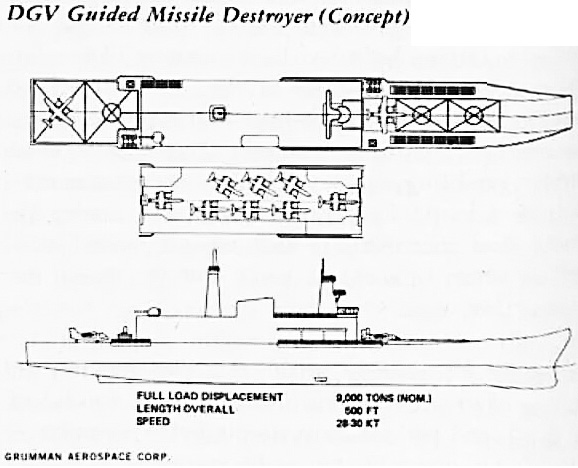
Cocker’s proposal of a “through-deck” small carrier based on the Spruance hull, probably the most advanced of all conversions proposals.
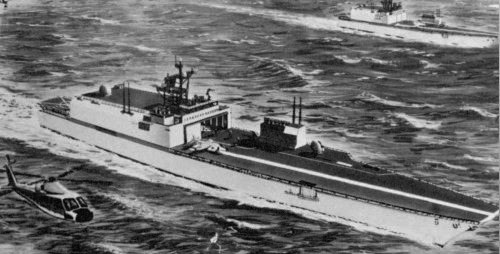
“Through-deck spruance carrier” artist impression.
Apart the previously seen conversion project, there was also a later flyable mini-V/STOL aircraft carrier based on a Spruance hull, carrying AV8B Harrier 2 and ASW helicopters. This project was seriously considered, but never built. It registered with the numerous attempts to revive the “escort carrier” concept in the cold war USN, like the SCS and VSS.
See also cold war usn aircraft-carriers
The modernized variant for ROCS
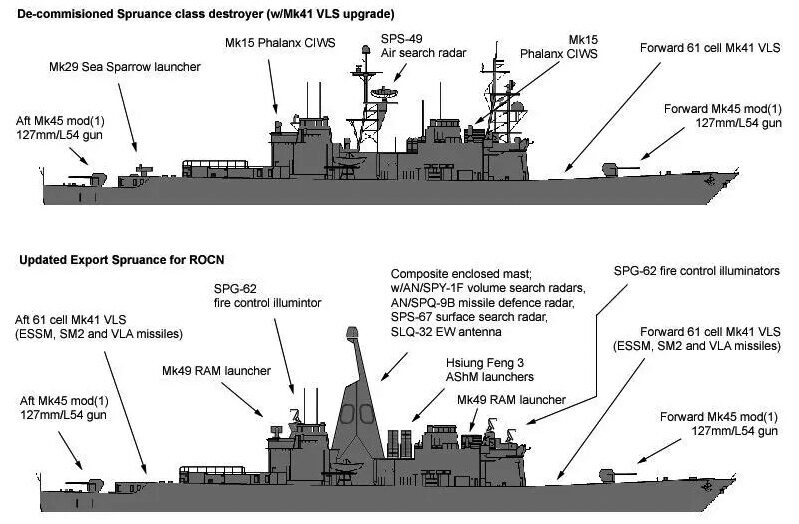
Of its 31 Spruance class, 7 were decommissioned in 1998 and the received a 61 cell Mk41 VLS but neither the SPY 1 radar or AEGIS combat system and its Mk41 operated a ground-attack Tomahawk. Decommissioned followed in 2005, 2006, 2007, 2008, 2009, the remainder in 2010 and 2013 although very good condition and expected for 20 years of more hull life. They were proposed as a perfect fit for the ROCN’s requirements when expressed. It had in this proposal a second 61 cell Mk41 VLS aft as in the Ticonderoga class for a total of 122 cells with VLA/SM2 plus four ESSM rounds. It could be fitted with a light weight composite mast mounting the SPY-1F radar and the modernized AEGIS combat system. The Mk15 Phalanx are swappable as a per-one basis by RAM launchers. Evetuallu Taiwan chose to built indstead (at greater cost but on strategic considerations) the local Hsiung Feng 3 supersonic missile, that could have complement the ship’s ASuW panoply.
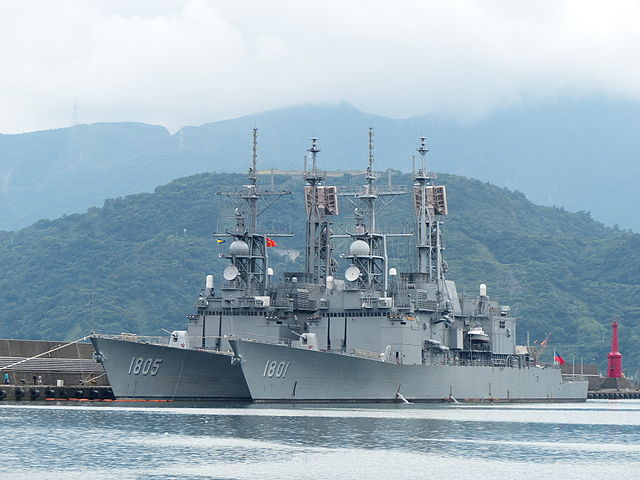
Estimation for this conversion was about half the cost of a new Arleigh Burke class ship at circa 600 million. But in the end, Taiwan’s four original Kee Lung-class (ex Kid class) were not upgraded this way. These are by the way the last existing Spruance today.
Read More
Links
navypedia.org
globalsecurity.org
man.fas.org/
destroyerhistory.org
navysite.de
secretprojects.co.uk
academic-accelerator.com
www.tapatalk.com
en.wikipedia.org
influenceofhistory.blogspot.com
laststandonzombieisland.com
Model Kits
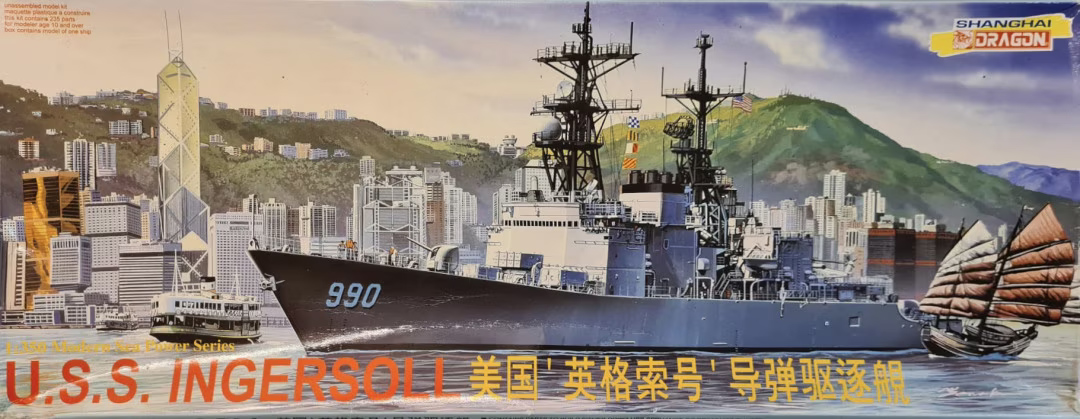
Zhengdefu 1:350 USS Ingersoll Kit
Although not super popular, the Spru-can was relatively well covered: Dragon made several of these at 1:350 and 1:700. Shanghai Dragon as well and Minicraft Model Kits, and ARII. Fujimi covered the 1:700 as well as Zhengdefu at 1:350 and 1:700. Foto-etch by Pit-Road had been released at 1:700.
General query on scalemates
sdmodelmakers.com proposed a tailored, very large “yard model”, type of which are usually sported in top brass’s offices, up to 1/192
3D
sketchfab.com
free3d.com/
cgtrader.com
renderhub.com
turbosquid.com/
Video
1984 United States Navy & USS John Young DD973, TV Commercial
 Spruance DD-963
Spruance DD-963
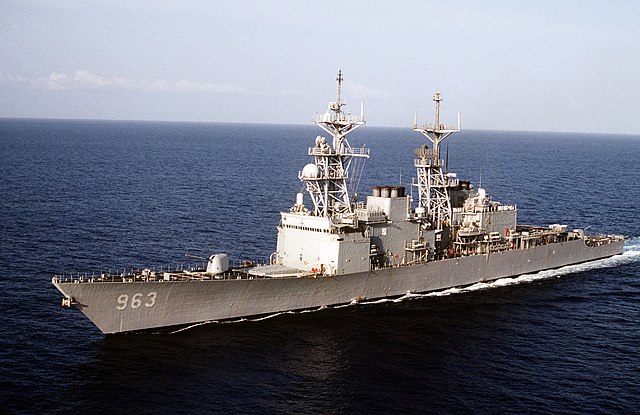
USS Spruance after commission was presented to the medias as a new breed of highly-capable anti-submarine warfare and anti-ship destroyers, first powered by gas turbines. However internall, the naval staff was not ahppy with a design considered under-armed for its huge size and operating costs. After commission in 20 September 1975, followed by years of training, a shakedown cruiser, post-fix trials, weapons trials, all in home waters, east coast. USS Spruance’s first operational deployment started by October 1979 to the Mediterranean, screening USS Saratoga Carrier Battle Group.
She sailed with USS Biddle, Conyngham, Milwaukee, and Mount Baker. She even transited into the Black Sea for ASW surveillance and shadowing the new Soviet helicopter carrier, Moskva, just out of the Soviet Red Banner Northern Fleet’s shipyard. Hower USS had issues with her LM2500 Gas Turbines and needed them to be replace when back home. She also perform the first clss underway replenishment breakaway flag RAS. A tradition was born when she unfurled the flag on the halyards by playing out the theme song from the 1976 film Rocky and sailing away.
Her first major refit was in 1980 at the Norfolk Naval Shipyard. Second Med Tod was without issue. She stationed off Beirut by June 1982 before being relieved and transited both the Suez Canal and Panama Canal during the same summer. Later in 1983, she received her Phalanx CIWS and TAS Mk 23 radar system. She was back for a third Med TOD to the Arabian Sea in 1983, stopping at Mombasa, Kenya in May 1983. She had a six-month TOD starting by January 1983 to the Persian Gulf with USS Oliver Hazard Perry as observers during the Iraq-Iran War. Next she took part in Teamwork ’84, northern Atlantic-Arctic Ocean in 1984 with NATO.
She started her 4th Med TOD in the Mediterranean from November 1984, second Black Sea Operations and back by May 1985. After her overhaul (VLS, Towed Array, SH 60 arrived). No records for 1986-88. On 26 January 1989 USS Spruance ran aground on a reef at low speed near Andros Island, Bahamas during ASW training exercises on the trench east. USS Boone had her towed away but she needed worth $1.8 million of repairs, including hull, propellers, sonar dome and forward mast. A junior officer in command at the time was discharged from the Navy.
Back to the Red Sea, under command of CTG 152.1 (Maritime Interdiction Forces), USS Spruance became flagship, task force commander and later for three different task force commanders. After exercizes with the Egyptian and Jordanian Navy she visited Hurghada for a crew leave and later Safaga, Aqaba, for an official visit. On 10 September 1993 she intercepted the 18,000 th ship since August 1990, the Maltese-flag “Early Star” in the North Red Sea, allowed to proceed since nothing was found.
She started another 6 month Med TOD bringing her from 26 May 1993 to the Red Sea supporting the UN sanctions against Iraq. With the Sixth Fleet she refuelled at Rota, Spain, and visited Palma, but also stopped to Augusta Bay, Souda Bay, and had a local maintenance period (IMAV) with USS Shenandoah. She crossed the Suez Canal on 29 June. Relieved as flagship by USS Hayler on 9 October and 170 interception, she crossed the Suez Canal back to the Mediterranean, stopping when back home to Toulon, Alicante, Rota and home Norfolk on 14 November.
In July 1994 she took part in Operation Restore Democracy, the UN embargo of Haiti, but she rescued some many Haitians, which had to be transferred to U.S. Coast Guard ships. She also carried 900 Haitians to Guantanamo Naval Station. She was in drydock in Portsmouth, Virginia and back by mid-1996 for 24th annual U.S. NATO Baltic Sea BALTOPS 96 exercise (47 ships and aircraft from 12 different squadrons, 13 NATO-member). She made another Med TOD from April to October 1997 with USS John F. Kennedy battle group. She became flagstaff of Destroyer Squadron 24, visited 13 foreign ports and participating in 5 multinational naval exercises, including the Black Sea, and became Presidential Support Ship in Rotterdam, and Thoule Sur Mer in France for the 52th commemoration of Operation Anvil Dragoon. She hosted an Ukrainian delegation for the 1997 Ukrainian Independence Day celebration and took part in “Sea Breeze 97” in the Black Sea.
By late 1999, she relieved USS Peterson at the Standing Naval Forces Mediterranean (STANAVFORMED) and deployed later to assist effort after Hurricane Floyd and Hurricane Gert, east coast of Florida, with the John F. Kennedy carrier group. By 1 June 2000, she was drydocked in Jacksonville, Florida, NS Mayport and left on 24 September 2001 for the John F. Kennedy Carrier Battle Group off Vieques Island for COMPTUEX exercise, also off Puerto Rican waters and preparation for 2002 Joint Task Force Exercise (JTFEX). On 19-26 January 2002 she took part in Phase I JTFEX and on 7–14 February Phase II off North Carolina and Florida. She was deployed a last time with John F. Kennedy carrier group in June 2004, until back to Mayport on 7 December 2004, decommissioned on 23 March 2005. She ended sunk as target by Harpoon missiles off the Virginia Capes, on 8 December 2006.
 Paul F. Foster DD-964
Paul F. Foster DD-964
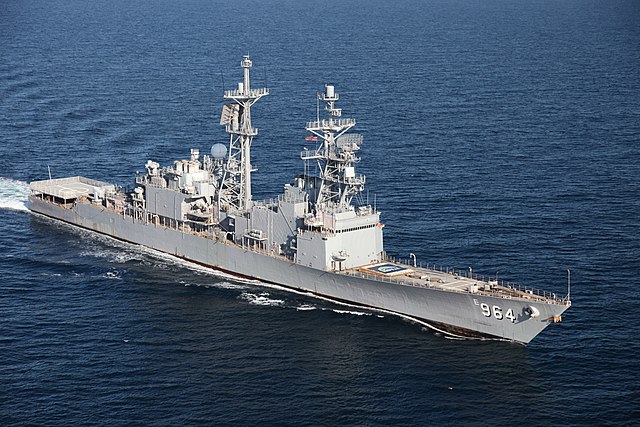
USS Paul F. Foster was commissioned on 21 February 1976, she was assigned to the Pacific Fleet, making many milestone firsts, notably by firing a NATO Sea Sparrow, landing H-46 helicopters, and testing the operational limits of the SH-3 helicopter. Homeported from San Diego, she was the first deploy to the Western Pacific in March 1978, 1979 and 1982, as well as Indian Ocean. She notably joined Destroyer Squadron Nine (DesRon 9) to Long Beach by August 1983. First “all electric destroyer” after an overhaul at the local Shipyard, she obtained a fourth service gas turbine generator. On 29 August 1984, she made her 4th WesPac deployment as DesRon 9’s flagship with Commodore, T.O. Gabriel and staff aboard. The five-ship surface action group too part in many allied fleet exercises.
Her 5th deployment from August 1986 saw her group attached to USS Carl Vinson‘s Battle Group; She was awarded the Meritorious Unit Commendation for her performance in Operation Kernel Potlatch between the North Pacific and Bering Sea. From July 1987 to July 1988 she was in overhaul at Northwest Marine Iron Works, Portland with 55 major alterations, receiving her Mk 41 VLS for Tomahawk missiles, AN/SQQ-89 ASW Detection System, and facilities for the LAMPS MkIII. Her 6th WestPac and Indian Ocean deployment started on 24 February 1989 this time with the Ranger Battle Group. She was active also in the the northern Arabian Sea, awarded the Armed Forces Expeditionary Medal.
On 8 December 1990, she made her 7th deployment to the Persian Gulf for Operations Desert Shield and Desert Storm. She was the first fire Tomahawk missiles against Iraqi targets. Her 8th deployment started on 20 July 1992, this time for Operation Southern Watch and taking part in bilateral exercises with Gulf Navies. For her 9th deployment, she returned with Carl Vinson’s Battle Group, rescuing the crew of the burning tug Glorious City, putting of the fire.
Back on 20 October 1994, she started a new overhaul at Long Beach Naval Shipyard and received several upgrades, notably the retrofit of a berthing to accomodate her first female crew members. She was moved afterwards to Everett in Washington from November 1995. Her 10th deployment from 21 February 1997, brought her back to the Persian Gulf, enforcing UN sanctions against Iraq. Her 11th deployment started on 27 January 1999 as part of the Pacific Middle East Force, but she took part in Operation Iron Siren, Eager Sentry, and Arabian Gauntlet, conducting many vessels boarding’s to enforce the arms embargo.
Her 12th deployment started on 11 January 2001, with the same missions. Her 13th was also her final deployment, on 18 June 2002. Back home, she was decommissioned on 27 March 2003. In 2004, she was to replaced Decatur as test ship, starting after some modifications in 2005. Assigned to Naval Surface Warfare Center in Port Hueneme Division she served that way until 2019. On 8 April 2011 she tested the Maritime Laser Demonstrator for a sea-to-sea target test, sinking a small inflatable motorboat at one mile in heavy weather. On 17 November 2011she tested a shipboard alternative fuel and went in the Pacific Ocean powered by a 50% algae-derived and hydro-processed algal oil with F-76 gasoline, travelling for 17 hours from San Diego. By 18 July 2016, she test-launched the LRASM Anti-ship missile from her VLS while underway in the Pacific. USS Paul F. Foster is still operational today as Self Defense Test Ship.
 Kinkaid DD-965
Kinkaid DD-965
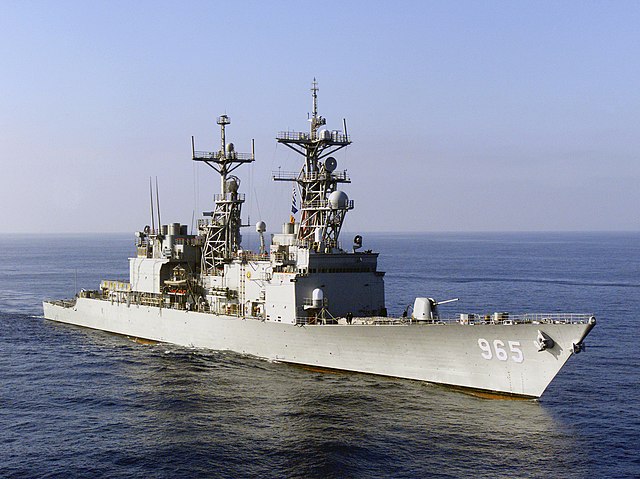
Starboard bow view of the US Navy (USN) SPRUANCE CLASS: Destroyer, USS KINKAID (DD 965) underway in the Pacific Ocean during work ups for a scheduled deployment.
USS Kinkaid, named after WW2 Pacific Admiral Thomas C. Kinkaid, was commissioned on 10 July 1976. She was busy doing her sea Trials, shakedown cruise, post-fixes and then intensive weapons tests on the west coast. During her first major middle east deployment, she had workers from Texas, constructing a naval base in the port of Char Bahar, Chabahar County, Sistan and Baluchestan province, Iran, when the revolution erupted and news fell of the Embassy being under siege. USS Kinkaid was the closest ship to assist and safely rescued the men on late evening of 22 February up to the morning of 23 February 1979, as well as families and other personal. They were evacuated to the small island of Bahrain, which became the “Gulf of Aden/Yemen Indian Ocean Contingency Operation of 12/8/78–6/6/79”. This provided her an early award, the Navy Expeditionary Medal and the Armed Forces Humanitarian Service Medal.
No records for the period 1980-88 but standard middle east commitments, NATO exercizes in the Mediterranean and Indian ocean, as well as overhauls.
In November 1989, USS Kinkaid collided with the Panamanian freighter M/V Kota Petani in the Strait of Malacca. This was violent enough for the destroyer to have 15 casualties and worth US$15 million in damages. She was repaired in Singapore, Subic Bay, and San Diego. On 4 July 1993, she visited Acajutla in El Salvador and served with DesDiv 13 from San Diego making two months of routine operations under Joint Task Force 4 in Key West, until mid-August 1993.
She made another 6-month deployment on 10 November 1994, with the Constellation carrier battle group to the western Pacific, Indian Ocean and Persian Gulf. In the Persian Gulf from 11 January 1995 until 23 March and she later took part in exercises like Beachcrest 95 between Okinawa and Ie Shima as well as Nautical Swimmer 95-2 and Nautical Artist 95–2 in the Persian Gulf asw ell as Eager Archer 95–1 with Kuwait and Sharem 110 in the Gulf of Oman and with the Royal Australian Navy off the coast of western Australia. Her 7th deployment was specialized in anti-submarine warfare, until an overhaul in June 1995, and after this she was reassigned to Destroyer Squadron 21.
By mid-1997 with Nimitz carrier battle group she joined the Pacific Joint Task Force Exercise 97-2 (JTFEX 97–2) off the coast of southern California as well as SURGEX while she performed mock aerial interceptions with Comstock and Ford and she escorted Viking Serenade is “war zone”. She later proceeded too the Pacific, visited Yokosuka and Hong Kong as well as Singapore until Iraq was caught violating the UN “no fly” zone, redirecting the whole battle group for Operation Southern Watch from 12 October via the Strait of Hormuz. USS Kinkaid was accused by Iran of spying on its own military exercises whereas she was in Bahrain. She was back to San Diego on 28 February 1998 after being there the Tomahawk ready strike platform.
Next she was reassigned to the Constellation carrier battle group, relieving Theodore Roosevelt in the Persian Gulf, from September 1999. She spent 10 weeks there between surveillance and operation boardings for Operation Southern Watch. She rescued the container ship Sima Star sinking 70 miles (110 km) off the coast of Bahrain after a flooding. The crew landed by helicopter and managed de-list the ship enough for it to be to sail into Bahrain for repairs. She was home by 17 December 1999. Next was another 6-month Westpac on 15 March 2001, again with the Constellation carrier battle group and Boxer Amphibious Ready Group, which trained jointly quite hard until February 2001; This included a stay in the Persian Gulf.
The summer of 2002 saw the USN trying a new deployment type called “sea swap” 18-months on site with the same ship, just swapping crews at six-month intervals. Three Spruance-class destroyers selected were Fletcher, Kinkaid and Oldendorf, plus three Arleigh Burke-class destroyers for comparisons. Fletcher being first on station she was crewed after 6 month by one from Kinkaid. The latter then were flown to Australia or Singapore, and Oldendorf’s crew trained for the same. This happened just as the navy planned to decommission all three ships. Fletcher was the first back to be decommissioned. Eventually this was the turn of Kinkaid 7 January 2003. “Kinky-D” was sunk as target on 14 July 2004.
 Hewitt DD-966
Hewitt DD-966
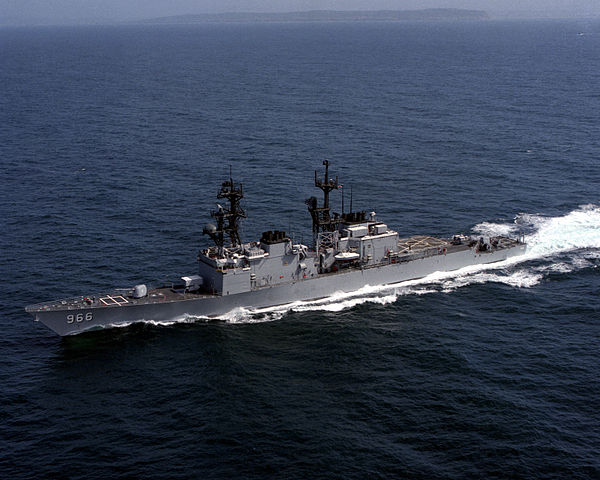
USS Hewitt was commissioned on 25 September 1976 as the fourth of the Spruance-class, one of the shiny new “Greyhounds of the fleet” and world’s largest general purpose destroyers. After sea trials, shakedown fixes and initial training, she went for Western Pacific by September 1978, assigned to 7th Fleet. She also made port visits to Australia, New Zealand, Fiji and Hong Kong. Back to San Diego in April 1979 she was prepared with RIMPAC exercise in February-March 1980.
She departed for her first major deployment abroad on 15 May 1980 with Battle Group Charlie in the Indian Ocean, showing the flag in a Middle East crisis. One goal was also to pressure Teheran to release 52 Americans hostages. She won for this the Navy Expeditionary Medal and Humanitarian Service Medal for recuring a Vietnamese boatpeople in the South China Sea as well as Battle “E” for DesRon 21 top performer 1979 and 1980.
Hewitt entered Long Beach Naval Shipyard on 19 May 1981 for overhaul and extensive modifications to improve survivability, new combat systems and followed by a long re-qualification, retraining until making her 3rd TOD on 21 March 1983 with the USS Midway, Coral Sea and Carl Vinson Btalle groups and independent operations in the South China Sea. Her fourth deployment started on 18 October 1984 with Battle Group Charlie, between the Western Pacific and Indian Ocean. By January 1985 she won the record at the Philippines Tabones Firing Range for Naval Gunfire Support. In February-April 1985, she was in the North Arabian Sea, and Gulf of Oman, earning the Meritorious Unit Commendation. She was back home San Diego on 24 May 1985.
By 1 September 1985 with DesRon 31 she constituted the first specialized ASW Squadron of the Eastern Pacific under Commander 3rd Fleet. This went on until April 1987 and a second overhaul from May 1987 to November 1988 at San Diego. She earned a VLS, Tomahawk Missiles and CIWS as the new LAMPS MK III helicopter and in complement the new SQQ-89 Sonar System. With DesRon 21 she was in the Persian Gulf on 18 September 1989 and back home on 16 March 1990, to be later homeported to Yokosuka.
Reassigned to Destroyer Squadron 15 on 25 August 1990 from Yokosuka, she mutltiplied exercises with the JMSDF, ROKN, RAN, Singaporean Navy, and transited to the Mediterranean to take part in exercizes with Brunei, Saudi Arabia, then NATO partners Greece, France and Spain, but also the Russian and British Navies. She was flagship for the Maritime Interception Force (MIF) and took part in Operation Desert Storm in 1991 with a stay in the Persian Gulf in April 1993. She made a 7th deployment with her first Tomahawk strike against Iraq but also with other ships like the Russian destroyer Admiral Tributs. She was again flagship of the Maritime Action Group (MAG) by October and was awarded the Meritorious Unit Commendation for the 1992–1993 campaign and 7th Fleet’s USW “E” Award for 1993.
Next after availability and small refit, she took aprt in RIMPAC’94 with live missile firings near Barking Sands in Kauai (Hawaii) and NATO Sea Sparrow engagement as well with the Penguin anti-ship missile (HSL 51 Detachment) by 25 June. She was in the Persian Gulf on 5 September 1994 and back to Yokosuka on 10 January 1995, bein awarded a second “E” by the 7th Fleet command for this year. By 17 March 1995 she started a refit until 5 September 1995 followed by multinational USW exercises and another “E” for general performance that year. For 1996, she joined in June the Persian Gulf, supporting the 5th Fleet and Operation Desert Strike, launching two Tomahawk on 4 September 1996 and later earning another Meritorious Unit Commendation. She was back in Japan on 30 October 1996.
In March 1997, she was in battle group exercises (USS Independence) and with DesRon 15 for Sharem 120B in the Yellow Sea with ROKN. Another port availability had her becoming “mixed” with proper women quarters, which personal reported in July. On 24 August 1997, she was homeported to NS San Diego and jouined DesRon 23 (29 August 1997) there. By 27 January 1999 she departed for the Middle East, to enforce U.N. Sanctions against Iraq and controlled merchant shipping. She was back on 26 July 1999 followed by Restricted Availability until 7 November 1999.
Her short records ends there: She was decommissioned 19 July 2001, sold for scrap to a Texas company on 9 August 2001, stricken on 5 June 2002.
 Elliot DD-967
Elliot DD-967
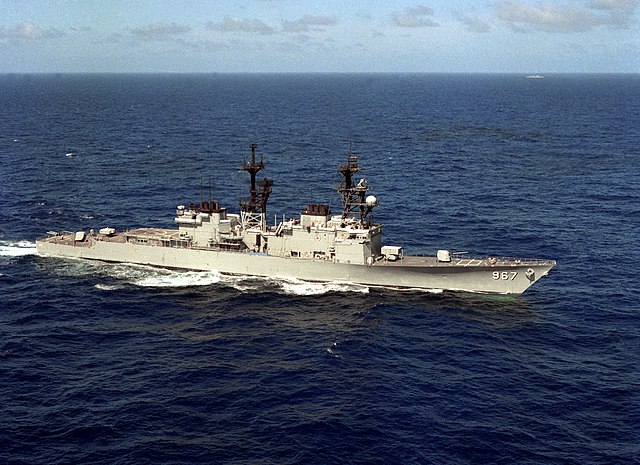
USS Elliot after commission, sea trials, made her maiden voyage on 24 January 1977 from Pascagoula in Mississippi to San Diego in California as she was assigned to the Pacific Fleet, DesRon 9 under Cruiser Destroyer Group Five, and this traduced by five weeks of shakedown training and first exercise. After her post shakedown yard availability she sailed northwards to Rockland in Maine (25 August), stayed for 4-day as she was named after a local sailor, and hosted many guests, including in a six-hour guest cruise. On 24 September she was back to Long Beach for a 6 month Shipyard refit, receiving both Sea Sparrow and Harpoons.
On 1 August 1978 she was reassigned tp DesRon 31 and made her first WestPack, for 7 months, starting on 21 February 1979 as flagship of DesRon 31, carrier group Ranger. On 31 March she departed Subic Bay for the Indian Ocean, crossed the Strait of Malacca to assist the collision of the carrier with oil tanker M/V Fortune, sending her back to Subic Bay. Meanwhile Elliot was in Diego Garcia on 12 April and joined USS Midway battle group for presence in the Gulf of Aden and back to Subic Bay on 15 June, where she awarded the Navy Expeditionary Medal. She was back home on 9 September 1979, having nootably the task for shadowing the Soviet carrier Minsk for five days.
Her second deployment in 1980 was shortened as on 23 January 1981, she had a main bearing disintegrating in the gas turbine and she was back in drydock for replacement, but at Subic Bay. On 21 April she recued one of many boat people. For hr rescue of these 158 refugees she was awarded the Humanitarian Service Medal. She notably stopped during this deployment Hawaii, Guam, Korea, Thailand, Hong Kong, Japan, and Singapore and was back home on 23 May.
On 1 June 1981 she joined DesRon 21, reported to Todd Pacific Shipyard, Seattle on 17 August for the first private sector overhaul on any of her class. She was installed the SLQ-32(V)2 AW system and was ready for trials on 30 April 1982, back to San Diego on 21 May and on 1 July reassigned to DesRon 17. She departed on 13 April 1983 for her 3rd deployment, saved another refugee boat on 31 July, and later weatherd two typhoons. On 1 September she rescued KAL 007’s crew, brought to Sasebo, remaining until 14 September. Later she encountered 32 Soviet ships in the area and so was in continuous Battle Stations until back home. Her third deployment started on 18 November 1983. On 27 January 1984 after leaving Seal Beach Naval Weapons Station she struck a subsurface obstruction and needed repairs. This started on 2 February (3 month SRA) in San Diego and by April, Todd Shipyard in San Pedro for hull repairs. In May she joined DesRon 5 and by October, took part in Fleet Week ’84 in San Francisco, hosting more than 10,000 visitors.
On 10 July 1985, she started her fourth deployment with USS New Jersey battle group. She made an exiercise with ROKA Navy, and assisted USS Darter after a collision with Kansas Getty. By December she joined the Kitty Hawk battle group to Pearl Harbor and was back to San Diego homeport for Xmas crew’s leave.
In May 1986 she started a two-month selected repair availability (flight deck mods for LAMPS Mk III notably) and by 11 she was in the fleet week’87 San Francisco and made her 5th deployment with notably a sortie through the Bering Strait. She had a major overhaul in 1988/1989 with addition of VLS, Phalanx CIWS, TACAN, upgraded Sea Sparrow, MK 23 TAS radar nd took part afterwards to PACEX ’89 in September, the largest US exercize in the Pacific since WW2, but with the JMSDF. She sailed again in the Gulf of Alaska and Bering Sea, then East China Sea and Sea of Japan stopping at Sasebo, before returning home by 9 November 1989. One tense point was when the 50+ ship formation was flew over by two Soviet TU-95 Bear D reconnaissance aircraft.
She started her WestPac-90 on 1 February with USS Carl Vinson Carrier Battlegroup “Charlie.” She made many ports visist, including Fremantle in Austrlia and took part in Team Spirit ’90 with ROKA Navy. She rescued another Vietnamese refugee boat on 20 April 1990, disembarked in Singapore on 21 April. This ended on 1 August 1990 was just a day before Kuwait’s invasion. Instead she was NASSCO yards on 9 September until 17 December for an OVL. WestPac-91 started for her on 31 July 1991 with COMDESRON 17 aboard as flagship. On 21 October while off the coast of Kuwait she was alerted by French DGSE “Le Berry” ship to the presence of a drifting Iraqi LUGM-145 mine, 12 nm offshore Mina Al-Ahmadi. The disposal team was flown in from Bahrain and it was safely detonated. She was back home on 20 January 1992.
From May 1992 to August she was in restricted availability. From 16 November she started her “war on druges”, a five-week counter narcotics cruis, stopping Puerto Vallarta, Mexico and back home on 21 December. In Maine, she took part in the Portland Rose Festival. On 9 July she returned to the Pacific, Indan Ocean, and Midde east, stopping in the United Arab Emirates and Bahrain. By late August she was in patrol off the coast of Iran until November as anti-air commander and track coordinator, making some strike operations exercises and boarding merchant vessels.
After a last round of operations in 1993 to 2002, she was in San Diego, California for decommission on 2 December 2003. But not sold and instead with USS William H. Standley, sunk off the eastern coast of Australia (Exercise Talisman Sabre) on 22 June 2005, in the Coral Sea east of Fraser Island.
 Arthur W. Radford DD-968
Arthur W. Radford DD-968
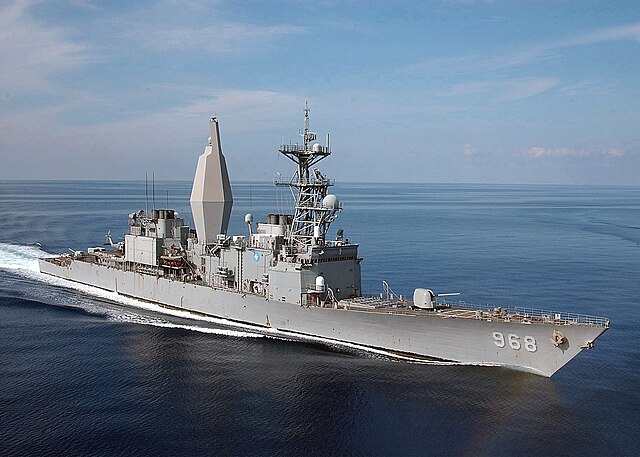
At sea aboard USS George Washington (CVN 73) Nov. 27, 2002. The USS Arthur W. Radford (DD 968), a Spruance-class destroyer, steams in the Mediterranean Sea. The Radford is part of the George Washington Battle Group on a scheduled six-month deployment. (U. S. Navy photo by Photographer’s Mate Third Class Summer M. Anderson)
She was commissioned on 16 April 1977, but stayed on the East Coast for more yard fixed and departed for good on 30 April for South Carolina (May) and her homeport of Norfolk in Virginia. Next she was off Newport, Rhode Island got Naval Surface Warfare Officer Training Command. Later off Norfolk she conducted gunnery exercises and helicopter operations. Off Port Canaveral, she embarked Capt. R. K. Albright, DesRon 22 commander for operations watched by President Jimmy Carter aboard USS Los Angeles. She resumed local operations later but went into a storm and has light damage. Next she was West Indies for training and gunfire support and back to Charleston, last day of July.
She was in Pascagoula for post-shakedown availability and back to Norfolk by mid-October, for restricted availability (RAV) into the spring of 1978 for qualification trials. After leaving Naval Weapons Station Yorktown Virginia she headed for her first NATO exercise in the North Atlantic as well as Ex. “Common Effort” in opposed Atlantic transit and hosted Vice Admiral Wesley L. McDonald, 2nd Fleet. After Operation “Northern Wedding” with the RNB, Royal Danish, Norwegian Navy, Swedish Navy, BundesMarine and RCAN, she went into the path of Hurricane Flossie.
Next she visited Copenhagen, Rotterdam and Portsmouth, England with VADM McDonald on 16 October and back to Norfolk on 25 October. Her first deployment was on 13 March 1979 for the Mediterranean with the 6th Fleet. Six months of NATO exercises and ports visits (Sicily, Yugoslavia, Italy, Egypt, France, Spain). She tried her Harpoon missiles on 28 July on target ship ex-USS Lansdowne (later Turkish TCG Gaziantep), “Multiplex 1-79” in the Ionian Sea, “Dawn Patrol” in the Tyrrhenian-Ionian Seas, “Tridente” off Alexandria, “National Week” XXVII. Off Toulon she rescued the French ketch Laurca. She left Rota on 12 September for HP Norfolk via Miami where she proceeded to helicoper qualifications. Back to Halifax, she took part in an exercize with the RCAN “Canus-Marcot” in 1979. In 1980s she stayed along the eastern seaboard (Halifax-Caribbean) and notably hosted Admiral James L. Holloway III, former CNO.
On 21 June 1980 and with Rear Admiral Peter K. Cullins (South Atlantic Force Command) and staff she became flagship for UNITAS XXI. Next were four months with many south am navies and port visits, until 4 November. Next she sailed to Gabon (West Africa Training Cruise) and otheer african countries before going home via Guadeloupe in December. The next two years were spent off the East Coast-West Indies and she had a first overhaul. She notably later assisted the Coast Guard on drug interdiction duties.
She made her 3rd Med TOD in 1983, via the Bahamas with DesRon 26 commander aboard and Secretary of the Navy John F. Lehman, Jr. before proceeding to the Mediterranean. Via Gibraltar and Augusta Bay in Sicily, she arrived off the coast of Lebanon to support peacekeeping forces in Beirut in May. She made a sweep to the black sea and visited the Romanian port of Constanţa, still as flagship, VADM William H. Rowden, 6th Fleet. While in Istanbul she hosted former General Alexander M. Haig. Back off Beirut in September 1983 she was used as gunfire support ship, relieved by the more potent USS New Jersey on 8 October. Later she joined USS Dwight D. Eisenhower battle group begore proceeding home.
In 1984 after some service off the Virginia Capes she was overhauled at the Metro Machine Shipyard in Portsmouth, sea trials and fixes before some retraining off Norfolk. Later she became flagship, DesRon 10. and accompanied the recommissioned USS Iowa to Roosevelt Roads. Her 4th deployment was with the Middle East Force from 4 February 1985 with USS Barney, Antrim and Charles F. Adams, made a RAS to USNS Waccamaw, and started their campaign from Rota, Naples, Egypt, Suez, Raysut, Oman and Strait of Hormuz to the Persian Gulf for radar picket station. She assisted the attacked tanker Caribbean Breeze. Apart radar picket station she patrolled the area, later flagship for RADM John Addams (Middle East Force Commander) in April-June. She was relieved by USS Comte de Grasse and later patrolled the coast Yemen She was back on 5 August 1985.
By late 1985 she took part in exercise, SHAREM 62 off Newfoundland and back to Halifax. She headed for Norfolk (13 November), Boston, Massachusetts (December) entering a restricted availability until late March 1986, later making a refresher at Guantanamo Bay. In October she assisted the Coast Guard law enforcement detachment and hosted the Caribbean Squadron commander and staff. She took part in SHAREM 1-87, FLEETEX and UNITAS XXVIII. She had a new OVL receiving VLS in January 1990 at Avondale Shipyard. Next she spent 6 month in the Persian Gulf with USS Eisenhower battle group, back on 26 March 1992.
She mad two more in 1994 and 1996, receiving several awards also for her deployment to Bosnia. By 31 August 1995 she was reassigned to DesRon 26. By May 1997 she was the first to receive the Advanced Enclosed Mast/Sensor System fully integrated advanced materials along with new sensor technology for electromagnetic disturbance and signature reduction, something help improving the Arleigh Burke class. This distinctive tall mast however did not hosted the AEGIS system. On 4 February 1999 she collided with the Saudi Riyadh container ship while off the Chesapeake Bay, heading for Baltimore while performing calibration tests on electronic warfare equipment, making circles around an electronic buoy. She was hit 30 feet (9 m) behind the bow with a deep gash on her starboard side of 8 m deep into her main deck, to her centerline and the gash extended to the waterline while she lost her 5-inch gun and had the Tomahawk canisters badly damaged plus 12 injured sailors. She stayed in Norfolk Naval Shipyard Drydock by February to September 1999 for $32.7 million in damage repairs.
She made a refrsher from 26 March followed by a new six-month Med TOD with USS Theodore Roosevelt battle group after new repairs by 13 September and joining the Eisenhower battle group. She was in the Persian Gulf from 3 April to 1 October 2000, but this was her last. She was decommissioned on 18 March 2003, stricken on 6 April 2004, transferred to the State of Delaware for sinking as artificial reef 30 nmi (56 km) southeast of Cape May in New Jersey and off Ocean City, Maryland. This was done on 10 August 2011, the largest artificial reef on the U.S. East Coast.
 Peterson DD-969
Peterson DD-969
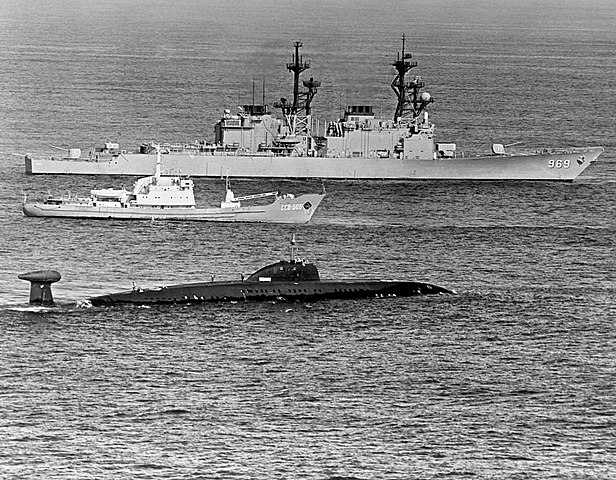
Peterson was Commissioned on 9 July 1977. After sea trials, shakdown cruise and post-skakedown availability, then weapons qualifications in 1978 she was prepared to be deployed in 1979 to the Persian Gulf. This first deployment was as flagship for Commander, Middle East Force and Indian Ocean as aprt of DesRon 10, being awarded a Battle ‘E’. The next year she returned in the Persian Gulf In Support of Iran Hostage Crisis from September 1980 and back home in March 1981 awarded the Navy Expeditionary Medal on “Camel Station” (Straits of Hormuz).
In 1981 she was deployed in the Mediterranean deployment until 1 December 1981 followed by an overhaul the next year, for 9 month from July 1982, with installation of TAS, Vulcan Phalanx CIWS mounts, better communications and electronics. She stayed home in 1983 to refresh training and re-qualifications of all systems.
In 1984 she took part in the Lebanon detachment, being awarded the Armed Forces Expeditionary Medal after her naval gunfire support off Beirut, in the Saratoga battle group, starting in April. In 1985 she made an Arctic deployment and NATO exercise ‘Ocean Safari’ (North Atlantic), earning her ‘Blue Nose’ for crossing of the Arctic Circle, as well as a Meritorious Unit Commendation for exceptional performance. In 1986 she returned in hotter waters of the Mediterranean, this time off Libya, with the USS America battle group. This was mostly DAR watch duties during combat operations but she was awarded the Navy Unit Commendation. In 1987 she was in refit and availability, the refresher cruise.
in 1988 she made another Mediterranean deployment as flagship, Commander, DesRon 26 and muktiplying exercises with British, French, German, Spanish and Tunisian navies. No record for 1989, but by 1990 she made a Mediterranean tour and deployment off Liberia with the Dwight D. Eisenhower battle group. She stand watch during the civil war and embarked Marines to assist the evacuation of American citizens. She also evacuated some 1,600 refugees with USS Saipan and her Marine Group, then back home in September.
In 1991 she had her second major overhaul of her career, starting on March 1991 and lasting for 13 month at Ingalls, her Mississippi builder. She received notably her Mk 41 Vertical Launch System as well as her SQQ-89 ASW SONAR suite, twin RAST tracks for new LAMPS III SH-60B helicopters. She emerged for a refrsher, requalifications and tests of all systems, missing the gulf war, but in shape the next operations. By 1993 she was in the Red Sea for Operation Desert Storm and by 16 February 1993, made a six-month Middle East Force deployment, boarding 247 vessels as part as the UN arms embargo. With her ropahawk missiles she was task to flatten the Iraqi intelligence headquarters in Baghdad with a volley of 14, on 26 June 1993, winning for DesRon 2 a new battle efficiency award.
In the summer of 1994 she took part in Operation Uphold Democracy, the evacuation and protection of US citizens during the civil war in Haiti. In 1995 she made a new Mediterranean deployment with the USS Eisenhower battle group; followed by a selected restricted availability (SRA). Sje notably took part in the Project Handclasp program in October, the installation of the latest Tomahawk Weapons Control System and operations with DesRon 28 with a new battle efficiency award. 1996 was marked by her operting in the gulf of Mexico, in Counter drug operations, notably by June-July off the coasts of South and Central America, Eastern Pacific Ocean. In July 1997 she was in the Atlantic with NATO (Standing Naval Forces Atlantic Squadron) and operating with British, German, Dutch, Spanish, Portuguese, Canadian fleets.
1999 was another Mediterranean deployment as flagship for “Standing Naval Forces Mediterranean Squadron” with NATO, Kosovo campaign and the Persian Gulf in 2001-2002. She took part in Operation Enduring Freedom as Comskey guardship and Commander, DesRon 50 flagship for interdiction rounds, North Persian Gulf. She was hosting the Surface Action Group commander, JASK area, Gulf of Oman, North Arabian Sea and Pakistan, with 349 queries and 4 boardings; But on 18 November 2001 as eight U.S Navy members boarded the Iraqi oil-smuggling ship, Samra, a fire erupted and the ship sank rapidly with 2 of the USS Peterson’s boarding crewmen. The destroyer assisted USS Bonhomme Richard’s amphibious readiness group (Combined Task Force 51) for INTEL and reporting off the Horn of Africa (exercise Edged Mallet) between the Gulf of Aden and Red Sea. The 196-day deployment wa her last, and she left with all praised for her action. She made a last gun furing exercize while underway to Newport, Rhode Island, firing 100 rounds from her 5″/54 guns underway at high speed. She was decommissioned on 4 October 2002, stricken on 6 November 2002, sunk in a weapons test on 16 February 2004, western North Atlantic for the DD-21 program (DD(X), DDG 1000 Zumwalt). Her bell was saved though, now on display in Baldwin County, Alabama.
 Caron DD-970
Caron DD-970
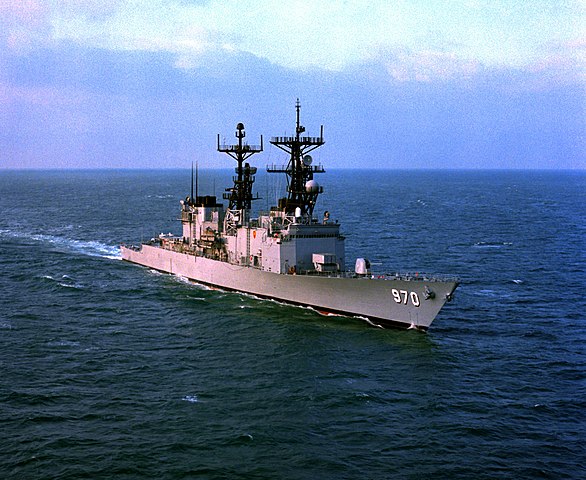
USS Caron was commissioned on 1 October 1977 and 1978-1982 were spend training and qualifying across the board. Her first combat deplpoyment was by October, 1983 for Operation Urgent Fury, the invasion of Grenada. She recovered a 20-man Navy SEAL/Air Force reconnaissance team on southwest coast prior to the operation. It came from USS Clifton Sprague and inspected the 9,000-foot runway under construction by Cuban workers at Point Salinas for future use. Heavy swells marred the mission, but it succeeded. USS Caron recovered 10 more SEALs close to the capital. A day after she made a third recovery, 11 Army Rangers left behind on Grand Anse Beach after the helicopter rescue of 233 medical students and staff from St. George’s University School, one of the key objectove of the mission. From November 1983 to March 1984 she was in the Mediterranean Multi National Peacekeeping Force in Beirut, Lebanon.
On 10 March 1986 she left Norfolk with USS America carrier battle group and took part in the Gulf of Sidra action, in the Libyan freedom of navigation exercise. On 23 March 1986, she crossed Ghadaffi’s “line of death” with USS Ticonderoga and Scott but she did not used her weapons. Later while in the black sea, she was shadowed agressively by the Soviet Navy, until on 12 February 1988 Caron she was “bumped” (lightly rammed) by the Soviet Mirka II light frigate FFL 824. By 15 February 1990 her first overhaul was complete. She made another Middle East tour after the Iraqi invasion of Kuwait in 1990, and from January 1991, Operation Desert Storm.
On 14 October 1993 she took part in the sanctions enforcement operations against Haiti, prepositioned off Haiti after a called by President Bill Clinton, to enforce United Nations sanctions, waiting from these to come into effect. In April 1995 she took part in a large NATO mine countermeasures exercise off Denmark and by January-July 1996 returned to the Persian Gulf for Operation Southern Watch. From February to 3 July 1998, she returned to the Mediterranean/Persian Gulf witn USS John C. Stennis Carrier Group 7. She had the Light 46 (HSL-46) Detachment 3 with SH-60B Seahawk onboard for operations. She took part also to Exercise Shark Hunt 98 in April, off Spain.
She had a second and last overhaul between January to 4 June 1999 at Newport News notably to accommodate female crew. In June-December 2000 she was back to the Mediterranean Sea and Persian Gulf with USS George Washington battle group. Back home on 15 October 2001 she was decommissioned, stricken later sunk on 4 December 2002 prematurely off Puerto Rico as a result of explosives tests.
 David R. Ray DD-971
David R. Ray DD-971
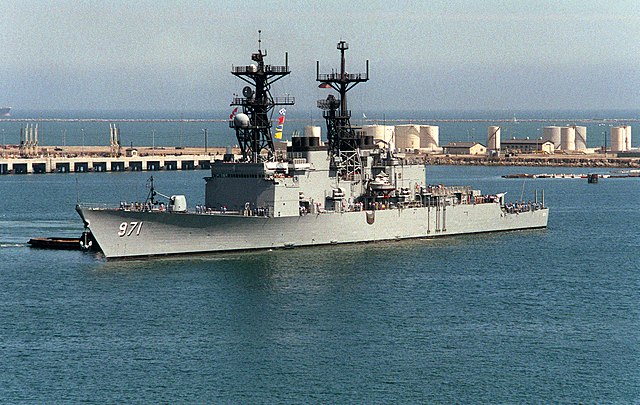
A tugboat prepares to turn the stationary US Navy (USN) Spruance Class Destroyer USS DAVID R. RAY (DD 791) as the ship idles in the harbor.
After completion, she sailed from Pascagoula to homeport San Diego -PacFleet) and soon was nicknamed by her young and rookie crew “Sting Ray”. She crossed the equator on 16 May 1978. On 19 February 1979 she made history by intercepting a supersonic drone with her Sea Sparrow. From 8 September 1979 she started her 1sy WestPac to Pearl Harbor, Guam, Yokosuka, Inchon, Subic Bay, and Hong Kong. In 1982, she had a major overhaul in Seattle. On 18 October 1983 she went into the Indian Ocean, stopping at Pattaya for a joint Thailand-U.S. naval exercise. She sailed from the northwest Indian Ocean to northernmost Sea of Japan for SURVOPS on Soviet moves, notably the Kiev class Novorossiysk just completed.
Late 1984, she tested the early Rolling Airframe Missile System and by 15 January 1986 she sailed with Battle Group Foxtrot, preventing the boarding of the USN President McKinley by an Iranian Saam class frigate on 12 May 1986. She had a second major overhaul began in June 1988 while homeported to Long Beach. She tested her new Vertical Launch System, RAM, modernized NATO Sea sparrow RIM-7P and newly installed BGM-109 Tomahawk Block 2, ASROC, making her one of the best armed destroyer of her class. She made another WestPack which brgough her via the Indian Ocean to the middle east, Persian Gulf on 27 April 1990. She took part in Operation Desert Shield. She returned there on 22 April 1992 as flagship for the “Maritime Interception Force” operations and back on 22 October 1992.
David R. Ray returned to the Persian Gulf in October 1994, as flagship DesRon 50 for the same Maritime Interception Operations, boarding all suspect vessels, and bacl in April 1995, and ports visits to Catalina Island, Seattle Sea Fair and San Francisco Fleet Week before a 9-month second overhaul at Long Beach NyD starting in June 1996, while homeported to Everett, Washington, in July 1996. Ready for deployment on 20 May 1997, from the Western Pacific she returned to the Persian Gulf as “senior ship”, Middle East Force. She proceeded to 49 boardings, her ghelicopters som 700 flight hours in Interception back home in November 1997.
She was in restricted availability between 11 February and 15 April 1998 and departed on 9 March 1999 she was dispatched to assist with the sinking of the oiler M/V New Carissa off the coast of Oregon. The crew earned the Coast Guard Unit Commendation. By 16 April 1999 she returned to the Persian Gulf for PACMEF 99-2, Commander. She made 55 boardings and back on 4 October 1999. She took part next in various exercises, and on 29 April 2000 went to Puerto Vallarta escorting ex-USS South Carolina (CGN-37) towed to Bremerton for deactivation. By May 2001 she made her final deployment between the Caribbean and Eastern Pacific, war on drugs. By 28 February 2002 she was decommissioned and spent time in Sinclair Inlet, Bremerton, by 17 June 2008, she was towed to Pearl Harbor, sunk as a target in RIMPAC 2008, 11 July 2008 by eight U.S. and Japanese ships, and aircraft.
 USS Oldendorf DD-972
USS Oldendorf DD-972

USS Oldendorf started her career homeported to San Diego on the West coast, and spent some time in extra shipyard work in Long Beach and to Litton Shipbuilders (Pascagoula), making for this three Panama Canal transits in pre-commissioning and easrly trials for her first 12 months of service, follwed by weapons and systems qualifications. She was commissoned on 4 March 1978.
Her first Westpac deployment (May-November 1980) started with a joint Australian-American-New Zealand ASW exercise off Western Australian in August 1980. The second Westpac deployment, was with the USS Constellation Battle Group by October 1981 and to the Persian Gulf before stopping to Western Australia, Perth and home in May 1982, then overhauled (September 1982-July 1983) and third Westpac deployment (January-May 1984). She was homeported to Yokosuka, for the 7th Fleet in August 1984 and joined USS Midway battle group until back to San Diego in 1991. In November 1986with USS Reeves and Rentz she visited for the first time the port of Qingdao in China, a first since 1949.
In 1988 she took part in the Seoul Olympics security force (Nimitz battle group) earning a Meritorious Unit Citation. She later rescued Vietnamese refugees. For her first deployment to the persian gulf and taking part in the Gulf War she was commanded by Cyrus H Butt IV. She was the first US destroyer present after the invasion of Kuwait and earned the Combat Action Ribbon for her part to the naval blockade of Iraq. Back to to Japan in mid-1991 she sailed for Long Beach and its Shipyard for OVL. In late 1992 she was homeported to San Diego. By early 1993 she took par tin Joint Interdiction LEO operations with the USCG (war on drugs) until March 1993.
After exercise Eager Sentry (Native Fury ’94) off Kuwait (4-25 April) she covered the landing from Diego Garcia of more than 1,000 tanks, artillery and vehicles to Shuaibah harbor. As well as the I Marine Expeditionary Force; 7th Marine Regiment, 1st Force Service Support Group, Naval Beach Group One and trained with the Kuwaiti Army and British Royal Marines. With the reorganization of PacFleet she was reassigned to DesRon 23. On 1 December 1995 she made another TOD with the USS Nimitz Battle Group. By March 1996 she headed to watch the Chinese nuclear tests off Taiwan, and also joined USS Independence battle group in international waters. From there she joined the Persian Gulf for Operation Southern Watch.
She later took part in Pacific Joint Task Force Exercise 98-1 (PAC JTFEX 98-1) off California and was redeployed on 9 November 1998 for six-month with USS Carl Vinson battle group and USS Boxer Amphibious Ready Group, relieving USS Abraham Lincoln battle group/USS Essex ARG. She took part in Operation Desert Fox in December 1998 and another round fo Operation Southern Watch. By early 2000, she received the new SPQ-9B Radar Improvement Program with COTS and NDI and the Mk 86 Gun Fire Control System. By August she reushed on the site of an airliner crash on 23 August, an Airbus A320 from Gulf Air. Relieved by USS George Washington she took part in JTFEX 2001 by February. This was basically her last recorded mission. She was decommissioned on 20 June 2003,
Stricken on 6 April 2004 and Sunk as target on 22 August 2005.
 USS John Young DD-973
USS John Young DD-973
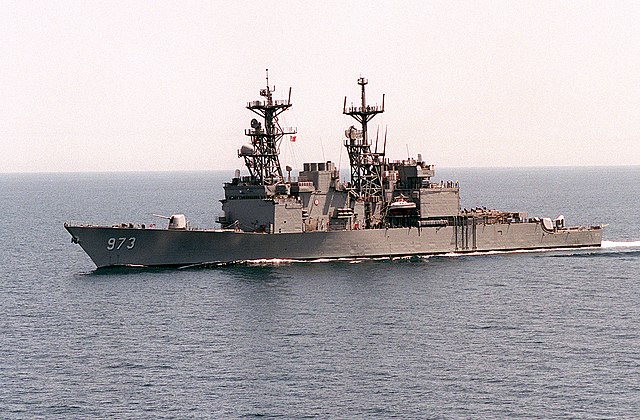
The Spruance Class Destroyer, USS JOHN YOUNG (DD-973), underway in the Persian Gulf in support of the Southwest Asia build-up.
USS John Young (named after a captain in the Continental Navy during the American Revolutionary War, commander of the Saratoga) was commissioned on 20 May 1978. After the usual sea trials, shakedown, initial and advanced training and qualifications, she was homeported to San Diego and made several WestPac TOD. No records for ten years but she visited Singapore by April 1981, and Sydney, Australia by March 1985, 1988 and 1994 and Vancouver in 1987.
In 1987, however during one of these 6 month deployment, she was deployed off the coast of Iran for Operation Earnest Will and participated in Operation Nimble Archer with Battle Group Echo, (USS Ranger, Missouri, Long Beach, Bunker Hill, and destroyers Leftwich and Hoel plus frigates and auxiliaries).
No records form 1988-93. Back home after a Congressional notification, she became one of the first 8 USN ships receiving accomodation for service women as crewmembers in 1994. Due to the reorganization in October 1995, she was reassigned to DesRon 23 and departed San Diego on 9 February 1996 to the Persian Gulf as part of the Middle East Force. This happened soon after she was gutted and refitted following a major fuel oil leak, trapping several crew members in pre-deployment, disabled firefighting systems and fire-proof escape doors removed for repairs. By 28 April 1998, she operated with the Coast Guard off Iraq, making the 10,000th boarding as part of the arms blocus of Iraq.
She left San Diego on 18 November 1997 again for 6 months in the Persian Gulf, operating with the Coast Guard Law Enforcement Detachment (LEDET) by late March 2001 as part on the war on drugs. John Young was decommissioned on 30 September 2002, stricken 6 November 2002 in Bremerton, and by 13 April 2004, towed to be sunk during exercise RIMPAC 04 by a Mark 48 torpedo. The latter broke her in half.
 Comte de Grasse DD-974
Comte de Grasse DD-974
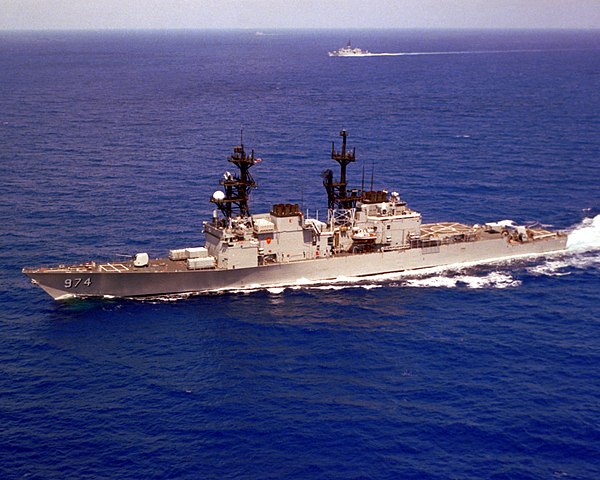
Commissioned in August 1978, Comte de Grasse was homeported to Norfolk and took part in initial training in the Caribbean, also stopping at Nassau, Bahamas. On 2 August 1979, she had a fire in Number 1 engine room in Norfolk with five sailors patrly burnt. It was needed to change the waste heat boiler and electrical gear and by fall 1979 she was a first overseas deployment, in Northern Europe for a NATO Exercises. She visited France (as commemoration given her name), Brest and Dunkirk, but also Hamburg and Portsmouth. Spring 1980, she visited New York City, under Captain Frank J. Lugo (his hometown). By March 1980 she took part in Exercise Safepass-80. Followed by a first MED TOD April and back in December. She made six more.
In February 1981 she fired at Vieques NGFS Range and took part in READEX 1–81 followed by a COMPTUEX off the Virginia Capes, Ocean Venture-81, exercise Magic Sword, Ocean Safari-81. She was refitted (Sonar Dome Rubber Window) and made her 2nd Med TOD from December, taking part in Exercise Sardinia-82 February-March, Exercise Norther Wedding/United Effort-82 August-October and COMPTUEX 1–83. Until July 1983 she operated with Standing Naval Forces Atlantic (Exercise Roebuck, Spring Train, Bright Horizon, May West, Nor Ops, Ocean Safari), followed by a drydocking until July 1984 at Ingalls. After Harpoon/Tomahawk Certification, CSSQT she made her Tomahawk Tactical Qualification Test and in May took part in COMPTUEX 2–85, followed by her first Middle East Force deployment on 6 June, taking part in Exercise Inferno Creek/Bright Star-85 and back in December.
In 1986 she mostly trained close to home but took part also in drug interception operations in the Caribbean. She took pat in BLASTEX 1–87, FLEETEX 1–87, was drydocked in March, followed by Solid Shield 87, FLEETEX 2–87 and another Med Tod until 17 November. By May 1988 she took part in a USN/FGN missile exercise This was followed by FLEETEX 2–88 some coast guard collaboration in the Caribbean, FLEETEX 1–89 and SOCEX 1–89 and in 1989, FLEETEX 1–89 befire drydocking in Norfolk (sonar dome rubber window) and another Med TOD in the Red Sea, Strait of Hormuz and back home on 9 November.
In 1990, after some retraining at the Vieques Gunnery Range (awarded the “Top Gun of the Year”) she was among the very firsr US ships visited by the Supreme Soviet of the Soviet Union and Chairman of the U.S. House Committee. In 1992 after the SWET Competition, FLEETEX 2–92, Exercise Fabric Falcon Brave, earning a 2nd Battle “E” Efficiency Award,in Destroyer Group 8. After a refresher Training off Cuba and FLEETEX 2–92 she reached the highest grade of any US ship in the whole Atlantic Fleet. Her next Med TOD started on 6 May (Saratoga carrier battle group); taking part in many and exercize Display Determination, and a sweep in Adriatic as the war went on in ex-Yugoslavia. In the red sea she took part in several maritime interdiction force operations and back home on 6 November.
On 19 October 1992 she trained with French destroyer De Grasse on the centennial of French Admiral Francois-Joseph Paul, Comte de Grasse with ceremonies in Grasse and Bar sur Loup in France as pat of the Franco-American friendship celebrations. Next she took part in Operation Sea Signal, Caribbean with drug operations, COMPTUEX, and Cherry Point operations. By 1994 her port main reduction gear has been sabotaged ($600,000 in damage) and was repaired before her next deployment on 5 February, Southern Adriatic (Operation Sharp Guard) and back in 24 June. Next off Haiti she took part in Support/Uphold/Restore Democracy. After COMPTUEX 95, she took part in UNITAS XXXVI-95 followed in 1966 by more drug operations in the Caribbean and by 1997 SPONTEX 97–1, INDEX 97-3 and UNITAS XXXVIII-97. She was among the first destroyers decommissioned, stricken 5 June 1998 in Philadelphia NISMF as a parts hulk (cannibalized) until towed off the coast of North Carolina in 2006 and sunk with USS Stump as target, resting under 12,000 feet.
 O’Brien DD-975
O’Brien DD-975
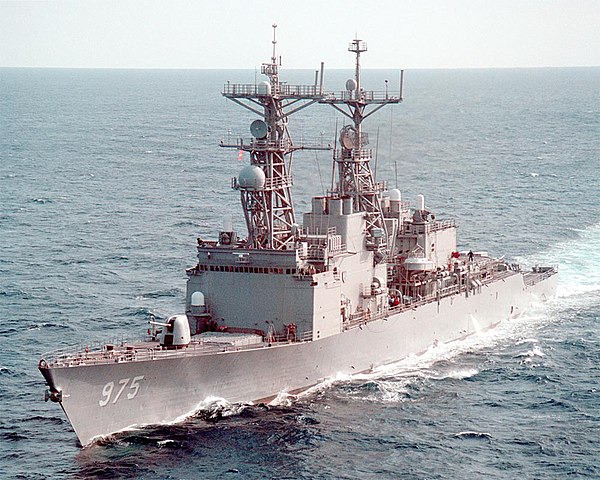
USS O’Brien completed seven major deployments to the Western Pacific and Indian Oceans and seven deployments to the Persian Gulf. Her third (13 January 1984–1 August 1984) was a record of 81 days at sea (Indian Ocean) in two refugee rescue missions, earning the Humanitarian Service Medal.
Her fourth WestPac (January 1986 – June 1986) comprised exercises TEAM SPIRIT 86 and TAE KWAN DO 86-1. For her fifth deployment, she was with the Middle East Force for Operation Earnest Will, Operation Praying Mantis. After extensive overhaul in 1988 she toop part in Operation Desert Shield, boarding some four hundred vessels. By December 1991 and February-April 1992, she took part in the anti-drugs patrols. In 1992 she was with the Forward Deployed Naval Forces, Yokosuka. By 1993 she returned with the Middle East Force for Operation Southern Watch. She made a fourth of these deployments from February 1995 patrolling to enforce the embargo on Iraq.
In 1996 she made her fifth and also took part in RIMPAC ’96 and trained with Taiwan. During her tour with PACMEF she seized over 1.5 million gallons of contraband oil. For her 233 days at sea that year she was awarded the “Battle E”, Meritorious Unit Commendation, Humanitarian Service Award and was nominated for the Spokane Trophy. She later took part in CROCEX ’99 with the RAN. In 2000, she spent 188 days at sea, took part in CSOFEX in Korea, COBRA Gold 2000, East Timor operations. In 2001 she took part in PACMEF ’01 in interdiction operations, boarding 30 ships. Later she took part in Tomahawk strikes into Afghanista (Operation Enduring Freedom). By 2006, now decommissioned, stricken, she was spent as target by missiles from HMCS Vancouver and gunfire from USS Lake Erie near Kauai (Hawaii).
 Merrill DD-976
Merrill DD-976
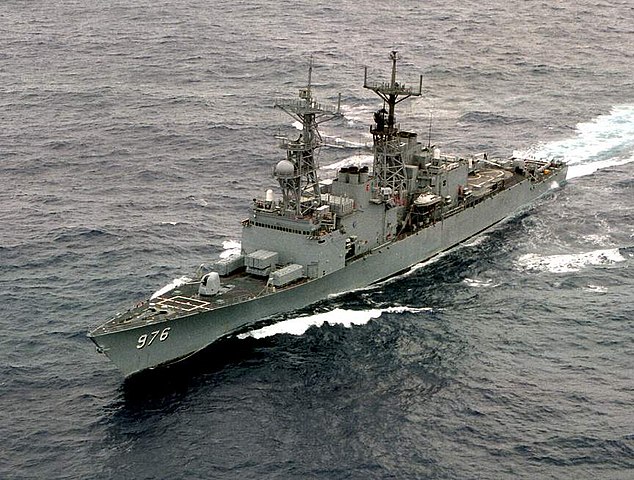
USS Merill was commissioned on 11 March 1978 and after her two years of peacetime shakeup, training, qualifications, she started her first WestPac from August 1980, rescuing Vietnamese refugees, and becoming a test platform for the Tomahawk Cruise Missile Program (award: Meritorious Unit Commendation). By 1986 she became flagship, DesRon 21 with Battle Group Romeo. In 1989, she sortied for the Middle East as part of the local Joint Task Force for Operation Earnest Will.
She joined USS Abraham Lincoln carrier battle group in 1991, taking part in Operation Fiery Vigil by June, covered the minesweeping forces in the Persian Gulf and visuted Kuwait City. In 1992 she was in counter-narcotics operations. In September she started her major OVL at Long Beach. From San Diego in 1994 she became a test platform for the new RAM material, making her look stealthy (same radar signature as a tug). She returned in the Middle East in 1995 with Abraham Lincoln battle group. By July 1995 after the reorganization she was reassigned to DesRon 7. In 1997, she took part in PACJTFEX 97-1 and 3rd Fleet exercise with USS Constellation carrier battle group, USS Boxer Amphibious Ready Group, part of “FLEETEX”.
In 1997 she was deployed with the Constellation battle group for six-month (Indian-Pacific) and Arabian Sea from 16 May and trained with the Pakistani Armed Forces, ex. Inspired Siren 97-2 and Inspired Alert 97-2. USS Merrill was decommissioned and stricken on 26 March 1998, sunk on 1 August 2003 as target NW of Hawaii.
 Briscoe DD-977
Briscoe DD-977
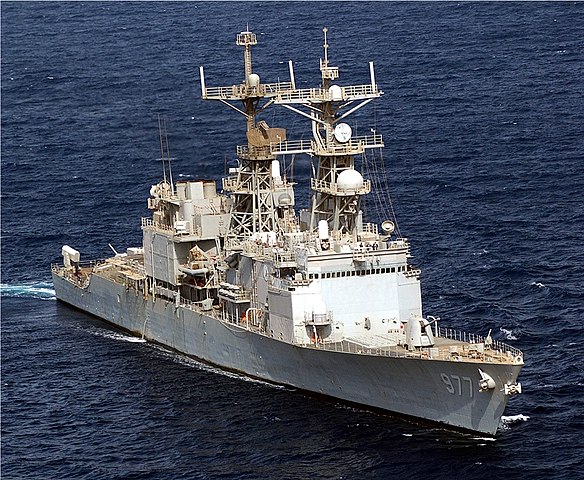
RED SEA ON BOARD USS BRISCOE (DD 977) (March 21, 2003) — USS Briscoe (DD 977), a surface combatant conducts underway operations in the Red Sea Friday in support of Operation Iraqi Freedom. The Norfolk, Va., based ship is assigned to Destroyer Squadron 22, commanded by Commodore M. J. O’Bryan..(U.S. Navy photo by JOC(SW) Alan J. Baribeau) .(Public Release per NAVCENT (PA)
USS Briscoe followed her sea trials, shakedown by weapons trials in 1981–1982 testing her SALGP (Semi-Active Laser Guided Projectile) at Vieques (Puerto Rico) with her 5 inch (127 mm) gun firng at targets 11 miles (18 km) away. She took part in Operation Urgent Fury (Liberation of Grenada) and was off the coast of Lebanon and Baltic in 1990. As part of the Middle East Forces, North Red Sea she made a record of 275 merchant vessel boardings in two deployments. On 19 May 1994 she rescued passengers from the Egyptian passenger ferry Al-Qamar Al-Saudi Al-Misri. By 1996, she toured the Mediterranean and Black Sea and took part in Exercise Atlas Hinge with the Tunisian navy, Shark Hunt and Jaws, Classica 96, with the 6th Fleet and NATO forces.
Upone 1999 Bill Clinton’s orders, she looked for the disappeared plane of John F. Kennedy Jr. In 2001 she provided emergency aerial defense, East Coast after the 9/11 terrorist attacks in NyC. In 2002 she joined Harry S. Truman Battle Group for Operation Iraqi Freedom, fired 25 Tomahawks in Iraq. She was decommissioned 2 October 2003, sunk as target on 25 August 2005.
 Stump DD-978
Stump DD-978
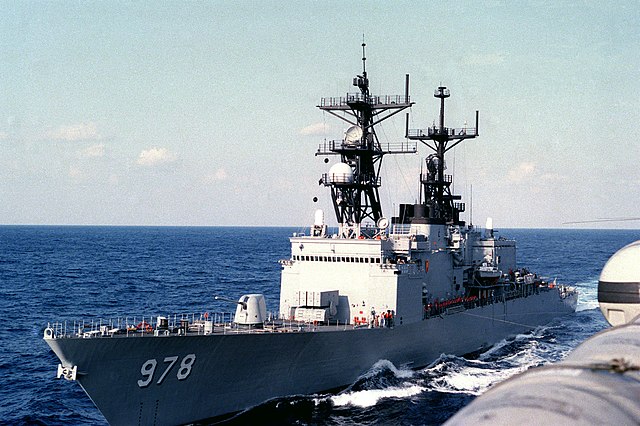
A port bow view of the destroyer USS STUMP (DD 978) underway.
USS Stump was commissioned on 19 August 1978 (named after Admiral Felix Stump, U.S. Pacific Command 1953 to 1958). She started with the Mediterranean as flagship DesRon 14. She also ventured in the Black Seaand later earned the “Hookem Award” for USW excellence, 6th Fleet. She took part in UNITAS XXII. By October 1982 she was in the Persian Gulf (Middle East Force) for radar picket operations. She took part in Solid Shield ’83, and had a major OVL in Brooklyn Navy Yd, frst of her class. She became after this the U.S. Navy’s host ship for the 1984 World’s Fair and later won the James F. Chezek Memorial Gunnery Award during gunfire support qualifications.
By March 1985 she hosted the admirak for CARIBOPS ’85, winning the Atlantic Fleet “Top Gun” award, followed by UNITAS XXVI/WATC ’85. and later awarded a Battle “E”. By 1988, she was in the Mediterranean with USS Dwight D. Eisenhower carrier battle group, relieving Samuel B. Roberts damaged by a mine. After coming home, she took part in Caribbean law enforcement operations and by December, she earned a 2nd Battle “E” for the Atlantic Fleet. In October 1989 she started her 4th Med TOD with the USS Forrestal carrier battle group (she earned the “Hookem” award again).
From August 1990 she had a major OVL at Avondale Shipyard, New Orleans. By November 1992 she was back in the Persian Gulf/Northern Red Sea as ready strike platform, launching Tomahawks during Operation Southern Watch on 17 January 1993.
By July 1994, she took part in UNITAS XXXV as flagship, South Atlantic Force. By February 1995, counter drug operations and SAR missions in the Pacific. She was later rassigned to DesRon 2 and made another Middle Eastern Force cruise, Persian Gulf, relieving USS Laboon and performing 40 boardings. By February 1997 she was in dry-dock for selected restricted availability. In 1998 she took part in COMPTUEX and JTFEX, Eisenhower carrier battle group. She later rescued the trawler Sara Ann in distress off Cape Hatteras. Back to the Mediterranean from June 1998 she took part in SHAREM 125 and the Fleet Battle Experiment Hotel, 2nd Fleet off the Virginia Capes and Gulf of Mexico. She also won the “Millennium Challenge 00” with the U.S. Army’s Joint Contingency Force Advanced Warfighting Experiment.
She started another Med TOD from November 2000 with USS Harry S. Truman and took part in JTFEX 01-1. She took part in the 2003 UNITAS exercise and made numerous Med port calls with her final deployment, in esxercizes with NATO partners. She was decommissioned on 22 October 2004, sunk as target with Comte de Grasse off North Carolina, 7 June 2006.
 USS Conolly DD-979
USS Conolly DD-979
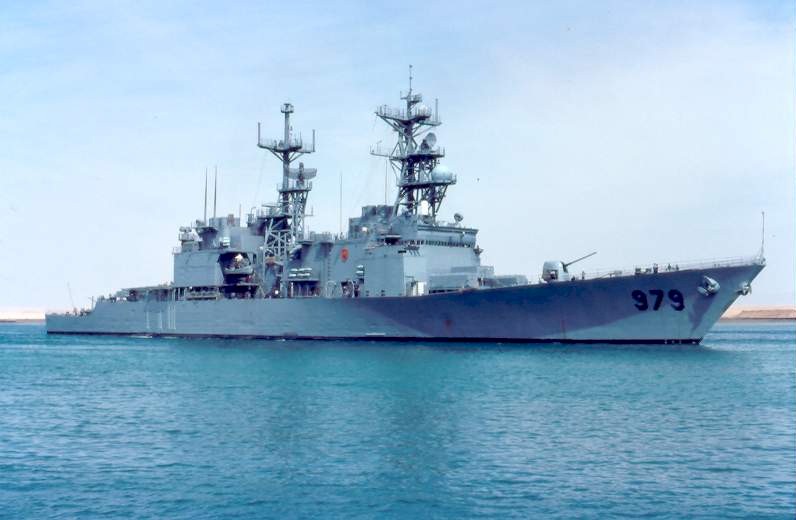
Conolly was commissioned 14 October 1978. In August-December 1980 she was deployed with the Middle East Force, and again in October 1981-February 1982. In May 1982 while off the Virgin Islands she suffered a cracked bow sonar dome, to be repaired at Newport News, but experienced a fire en route in the engineering spaces. September 1982 saw her back in the Mediterranean and Lebanon.
In June 1983 this was UNITAS XXIV with port visits. She became flagship for South Atlantic (COMSOLANT) Rear Admiral Clint Taylor. She developed again troubles in her LM-2500 Gas Turbine Main Engine. She made later her first West African Training Cruise (WATC). Her OVL started in February 1984 in Portland’s Bath Iron Works for 10 months. By October 1985 she was back with Middle East Force up to April 1986. Same story in June 1987, 1988 abd 1989 but also in 1992 MIF (Maritime Interception Force) during the Iraq war.
In she had an OVL at NASSCO Norfolk and by 1993, took par tin Operation Uphold Democracy off Haiti. On 6-10 June 1994 she took part in Op. Torch celebrations in France. Later she was in the Red for the arms embargo to Iraq, boaridng many shuos. By 12 July 1994 sje rescued 62 from ferry Al Loloa. After reorganization she was homeported to Mayport and later served with USS George Washington carrier battle group from January 1996 and took par in Joint Task Force Exercise 96-1, then SHAREM 114, INVITEX in February off Spain. After Operation Destined Glory 96 off Sicily she took part in other exercises with NATO fleets and by 11 April she was sent with USS Guam, Trenton and Portland to Liberia (JTF Assured Response). Next this was Operation Sharp Guard off Yugoslavia, controlling 121 merchant vessels. By June this was Exercise TAPON 96 in the Gulf of Cadiz with Principe de Asturias. By March 1997 she was back to Mayport, decommissioned 18 September 1998, laid up at Philadelphia with efforts to preserve her in Illinois failing. She was sunk as a target off Florida on 29 April 2009 (UNITAS Gold).
 USS Moosbrugger DD-980
USS Moosbrugger DD-980
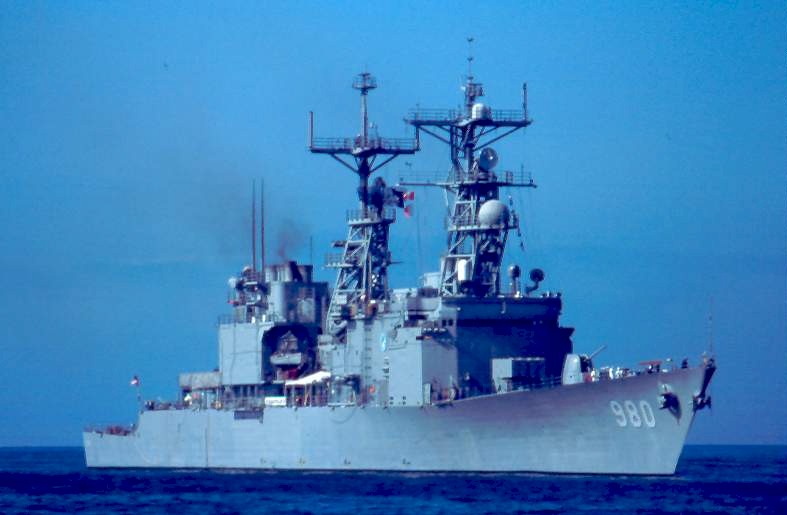
USS Moosbrugger was commissioned 16 December 1978, homeported to Charleston, east coast for shakedown, post-commissioning refits but she sailed out in emergency because of Hurricane Frederic, into the Gulf of Mexico. She made her first Mediterranean Tour of Duty (Med TOD) on 14 July 1980 as flagship DesRon20, earning a Meritorious Unit Commendation (MUC). In 1989, she made another deployment with USS Theodore Roosevelt Battle Group. Sge was present for Operation Desert Shield with USS John F. Kennedy Battle Group, to support enforcement of UN Iraq Sanctions, boarding 30 merchant ships bound for Jordan. Later she was posted in the Gulf of Aqaba. Back home she had an OVL at Charleston shipyard and was homeported to Mayport after the 1993 reorganization.
She was redeployed in 1996, for UNITAS 96, and by 1998, UNITAS 39–98, as USCOMSOLANT flagship (COMDESRON 32), and INDEX) 98-2 off Puerto Rico. No records for 1997-1999. She was decommissioned on 15 December 2000, towed to Philadelphia Naval Intermediate Ship Maintenance Facility and towed to Brownsville for dismantling.
 USS John Hancock DD-981
USS John Hancock DD-981
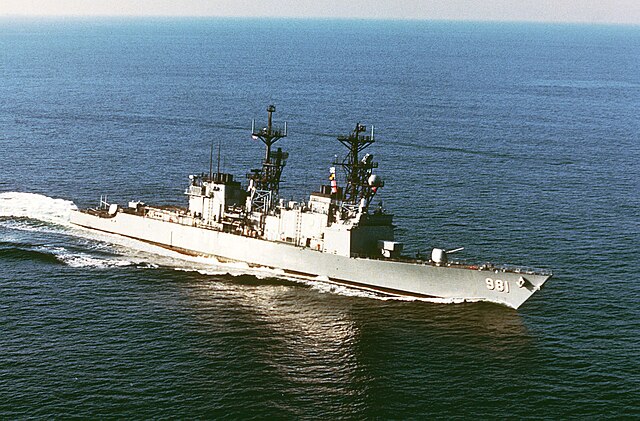
USS John Hancock was commissioned on 10 March 1979 with the Atlantic Fleet, HP Charleston until 1987. She started a 6 month OVL on March 1983 at Ingalls Shipbuilding, earned her GITMO re-certification at NAS Guantanamo Bay and sailed for the Persian Gulf in October 1984-April 1985. She escaped back home Hurricane Diana in September 1984. During the “Tanker War” between Iraq and Iran, she was targeted by an Iraqi Mirage launched Exocet missile, which narrowly missed her and hit a salvage tug. In April 1988 she took par tin Operation Earnest Will and assisted USS Stark hit by two Exocet missiles by 1987. In 1991, she joined USS America Carrier Battle Group (CVBG) for Operation North Star ’91.
By March 1994 in the Red Sea she took part in the multinational maritime interdiction operations against Iraq starting boarding operations. After reorganization she was reassigned to DESRON 24 with homeport shift. She fled Hurricane Fran in September 1996. That year she sailed with USS Wasp, Carl Vinson, Anchorage, and George Washington for the P2 afloat program on toxic material and hazardous waste. She started another deployment from 29 April 1997 with USS John F. Kennedy CVBG and USS Kearsarge Amphibious Ready Group (ARG) relieving USS Theodore Roosevelt CVBG after a JTFEX. By August 1997 she took part in Exercise NADOR 97-3 off Tunisia after NADOR 97-2. She took part in Invitex (12 nations) and was back on 28 October, taking part in Operation Deliberate Guard and Southern Watch. She took part in the 6th International Naval Review in New York City 3-9 July 2000 but was decomm. on 16 October 2000, sent to Philadelphia, sold in 2006 and BU 2007.
 USS Nicholson DD-982
USS Nicholson DD-982
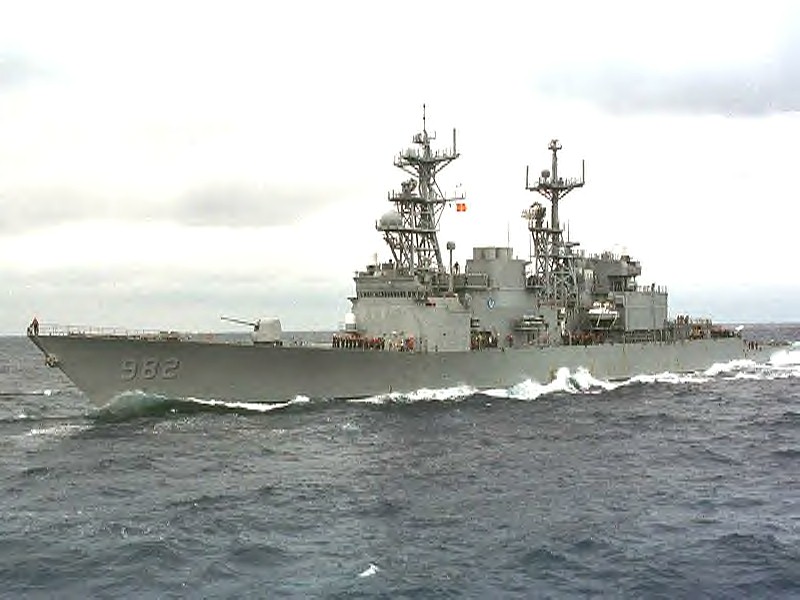
USS Nicholson was commissioned on 12 May 1979, deployed on 18 November 1980 and first time in the Persian Gulf by 1983 back to Charleston HP via Suez and Djibouti. In the Atlantic she damaged her sonar dome, repaired during her scheduled maintenance at Brooklyn NyD May 1984-Feb 1985. She started another long deployment by February 1990 with USS Dahlgren, Mid-East Force, Persian Gulf. Two armed Iranian F-4s overflew her in the Straits of Hormuz, and both ships left for home just a week before Iraq invaded Kuwait.
Nicholson returned for six months from January 1992 for Standing Naval Force Atlantic. She became flagship, Admiral, RADM Dwyer for a NATO exercises with norther Europe. By early 1994 sje joined USS Saratoga CVBG, Task Force 60, in the Persian Gulf, Mediterranean and Adriatic Sea for Ops. Deny Flight, Provide Promise and Sharp Guard. After the reorganization of 1995 she was reassigned to Desron 18. She was OVL and left Charleston NyD by 29 September 1995, last ship overhauled in this shipyard. Homeported to Norfolk on 6 October 1995 she made another deployment from 10 December 1996 to the Middle East Force, Persian Gulf and took part with USS Enterprise CVBG in SINKEX off Puerto Rico when back on 9 August 1998, taking part in sinking her sister ship USS Richmond K. Turner.
She made another deployment from 6 November 1998 to relieve USS Dwight D. Eisenhower CVBG in Operation Southern Watch, followed by Operation Desert Fox, launchinh Tomahawk missiles on Iraqi targets. She later joined the 6th Fleet for Operation Allied Force, launching Tomahawks in Yugoslavia and back home home on 6 May 1998. She collided with USS Detroit on 27 August 2000 east of Norfolk. She returned with Enterprise CVBG and USS Kearsarge ARG relieving USS Harry Truman CVBG/USS Nassau ARG taking part in Operation Enduring Freedom, firing Tomahawk missiles against targets after 9/11 as “First to Strike” and back home by November 2001. She was decommissioned on 20 December 2002, stricken 6 April 2004, sunk as a target 30 July 2004.
 John Rodgers DD-983
John Rodgers DD-983
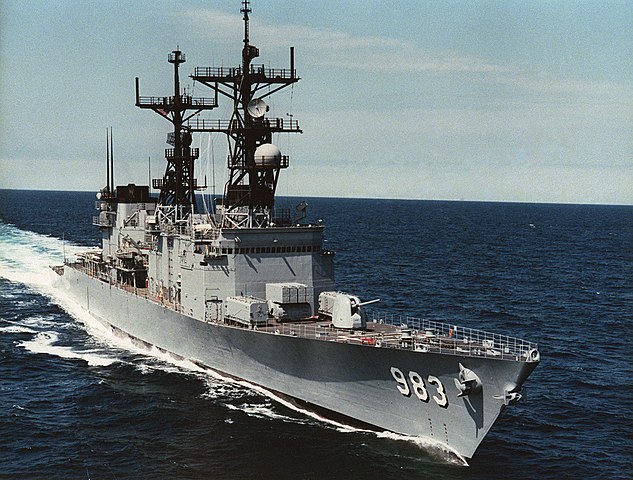
A starboard bow view of the Spruance class destroyer USS JOHN RODGERS (DD 983) while underway.
She was commissioned on 14 July 1979 and was in operations in the Atlantic, Pacific, and Indian Oceans under Commander Wagner. She spent several deployment in the Persian Gulf in support of Iraq during the war against Iran, and the “tank war”. She made made port calls on four continents. By September 16 1983 off Lebanon she fired her main guns against Syrian targets after a shelling near the residence of the U.S. ambassador and harassing fire on Marines at Beirut airport. It was the first live combat fire of this new gun in the USN. Along with USS Virginia she fired some 338 5-inch rounds and stayed on station until 21 September.
Back by 1991 in the Mediterranean she stayed off the coast of Israel when Iraq invaded Kuwait and took part in Operation Desert Shield. By 1993 she became flagship, Commander, South Atlantic Force in UNITAS XXXIV under Rear Admiral Wirt R. Fladd. By 1995 she took part in NATO Standing Naval Force Atlantic. Next she was in the Adriatic for Operation Sharp Guard. After closure of NS Charleston in 1995 she was homeported to Mayport in August and by January-March 1996 took par tin the northe waters NATO joint exercises. On 23 May 1996 she was in New York city fleet week. By 3 October 1997 she departed with MARG 98-1, USS Guam and later USS Kearsarge, taking part in Bright Star 97, Reliant Mermaid and three other major exercises. Back from the Persian Gulf she was in counter drug operations in the Caribbean Sea, and Operations Shield, Support Democracy, Sharp Guard.
She became flagship/COMDESRONs 14, 20, 22, 32, 36 and host ship for COMSIXTHFLT in 1988, COMSTANAVFORLANT in 1995 arning a Joint Meritorious Unit Award, Navy Unit Commendation, Meritorious Unit Commendation Battle “E”, National Defense Service Medal, Southwest Asia Service Medal and many others. She was decommissioned and stricken on 4 September 1998, stored at NISMF Philadelphia, sold and BU.
 Leftwich DD-984
Leftwich DD-984
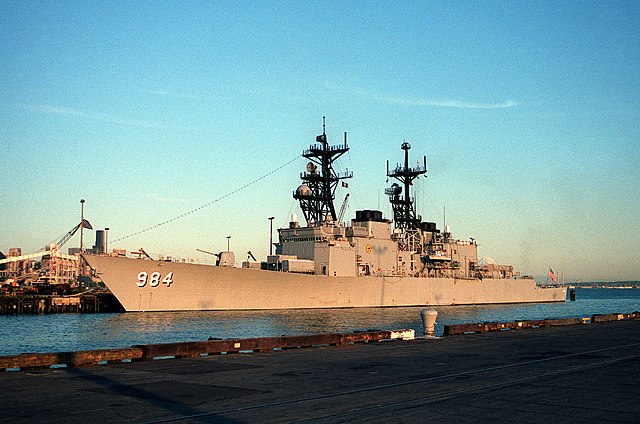
USS Leftwich was commissioned 25 August 1979 and she was homeported to San Diego until March 1985. She narrowly escaped Hurricane David and Hurricane Frederic making one of the fastest transits on record of the Panama Canal, chased off by Hurricane Guillermo and still experiencing 30 feet (9.1 m) waves. After Shakedown training she returned for Post-Shakedown Availability (installation of NATO Sea Sparrow and Harpoon) folloed by weapons qualifications. By 29 November 1982 she collided with sub. USS Thomas A. Edison (SSBN-610) east of Subic Bay during war games as the latter was at periscope depth. They were repaired at Subic Bay. It was for her sonar dome and forward fuel storage tanks for Leftwich as completed at Puget Sound Naval Shipyard. By 1984, she started her WESTPAC homeported to NS Pearl Harbor until the rest of her career.
Under command of Daniel Bowler she took part in Operation Nimble Archer on 19 October 1987 and later under Patrick Garrett, Operation Desert Shield/Desert Storm, making some 200 merchant ship interceptions, one boarding, fired her BGM-109 Tomahawk cruise missiles and make a wartime reload of Tomahawks. She captured the first Iraqi territory in al-Faw waterway, received POWs and made 16 SAR missioned winning Navy Unit Commendation Ribbon and Combat Action Ribbon. She made eight deployments, notably UN-backed ones against Iraq. She was decommissioned and stricken on 27 March 1998, sunk as target on 1 August 2003, Pacific Ocean.
 Cushing DD-985
Cushing DD-985
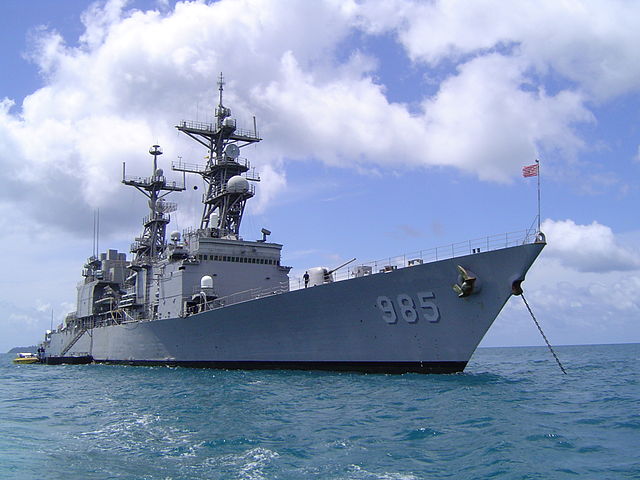
USS Cushing was commissioned on 21 September 1979, and joined the PacFleet, rushing to avoid Hurricane Frederic in the Gulf of Mexico, followed by outfitting and find her homeport San Diego, assigned to DesRon 31, specially modified as flagship and fitted with the AN/SQR-15 Towed Array Sonar System. She tested the rudder roll stabilization (RRS), later implemented on the Arleigh Burke-class destroyers. HP Pearl Harbor she made exercises in the North Pacific by 1991-1992 and visited Canada. In 1992 she took part in UNITAS 33, circumnavigating South America. In 1994 she had an OVL in Pearl Harbor.
After the reorganisation she was reassigned to DesRon 5. She tested a prototype Remote Minehunting System (RMS) by the Fall 1996. It was demonstrated in Persian Gulf exercise where she was conducting Maritime Interception Operations. On 16 March 1998 she was homeported to Yokosuka, Japan, replacing USS Fife (DD-991) relocated to Everett in Washington. She made four WestPac and a South Atlantic UNITAS tour. She was flagship DesRon 15 taking part in CARAT ’98 and with 7th Fleet MTX 99 in the Marianas Islands, 38th Foal Eagle by fall 1999. Later she was SHAREM with the Japan Maritime Self Defense Force and MISSILEX in November 2000, later earning the Silver Enlisted Surface Warfare Excellence Pennant on 25 January 2001, first DesRon 15 DD to qualify for this award. On 5 July 2002 she suffered a Sikorsky UH-3H Sea King from HC-2 tail rotor failure while landing, all survived. By 7 November 2003 she took part in Annualex 15G, and later became the very last Spruance-class ship in active service, decomm. on 21 September 2005. She was sunk as target on 14 July 2008 at RIMPAC 2008 with some sisters.
 Harry W. Hill DD-986
Harry W. Hill DD-986
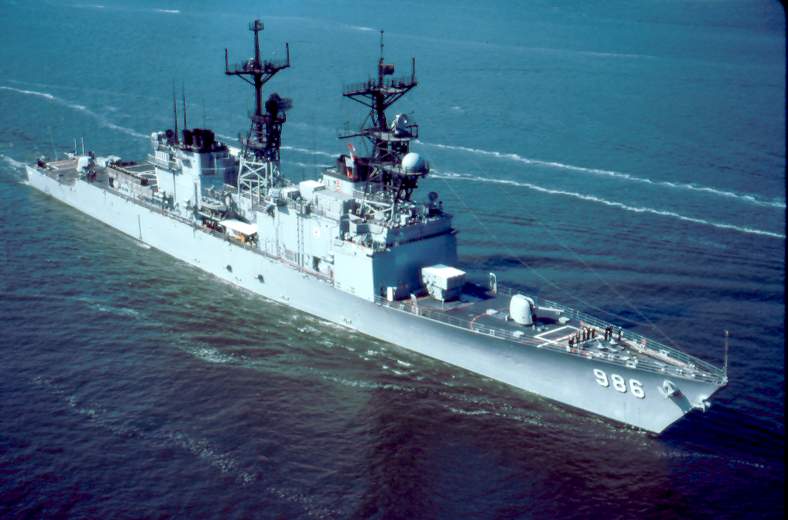
After commission and training, DD-986 started her first overseas deployment in early 1982. By late November she was detached from USS Enterprise CVBG to shadow the Soviet aircraft carrier Minsk, transiting the Indian Ocean for her first deployment to the Far East with intel experts aboard, and back on 19–20 January 1983. Later she took part in operations Desert Shield and Desert Storm, part. On 14 January 1991, she collided with the oiler USS Kansas City during a RAS in the Gulf of Oman. By 1994, she was damaged during a maneuver to re-float her, exit a dry dock, caught by a gust of wind and she had her rudders, screws, controllable prop pitch systems repaired. She became the only Spruance-class not to receive the armored box launchers or Mark 41 VLS. She served from HP San Diego for most of her career, decommissioned, stricken on 29 May 1998, sunk as target in RIMPAC 2004, 15 July 2004.
 O’Bannon DD-987
O’Bannon DD-987
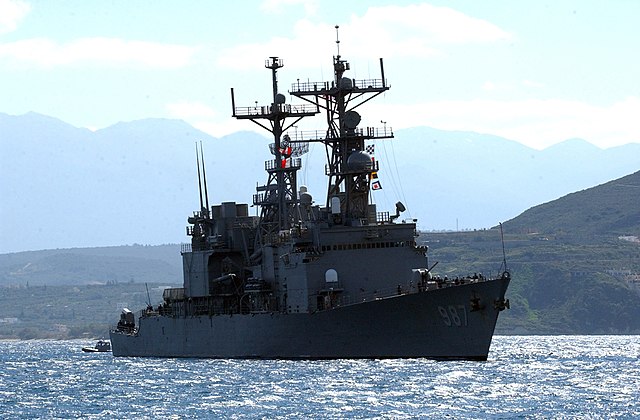
Souda Bay, Crete, Greece (Mar. 3, 2005) USS O’Bannon (DD 987) approaches the pier in Souda harbor for a brief port visit.
O’Bannon is one of only three remaining Spruance Class destroyers, and she was homeported in Mayport, Florida after commission on 15 December 1979, assigned to DesRon 4, and after a retrofit, joined DesRon 6, fitted with the full panoply including the AN-SLQ-32(V)2 Electronic Warfare (EW) system. She departed Charleston 18 March 1981, for a Med TOD and North Atlantic deployment. She took part in a freedom of navigation (FON) exercise off Libya, crossed the Arctic Circle on 1 September and by 9 April 1982 performed her READIEX 2-82 and Exercise Ocean Venture. From May 1984 she started a northern NATO tour. In 1985 she she was back in the Mediterranean, Indian Ocean and Persian Gulf for “Freedom of Navigation” operations around Libya and was assigned to CVBG USS America (CV-66), USS Coral Sea (CV-43) and USS Saratoga (CV-60. From October 1986, she made another six-month deployment to the Persian Gulf, Middle East Task Force and relieved by USS Stark.
After New York City’s Fleet Week 19-25 April 1988 she made another deployment 5 December 1988–21 July 1989. She took part in Square Shooter on 24 January 1991, and became flagship for UNITAS XXXII, making 17 port calls. Then was Ocean Venture 92 and in July she visited Severomorsk, Russian Northern Fleet, a first. She later received a Battle Efficiency “E” award/Command Excellence Award. She had an OVL in January-July 1993, followed New York City’s Fleet Week 94 and homeported to Mayport. She made another Med TOD on 3 March-22 August 1995 with DesRon 8 but after reorganization, joined DesRon 24. She took part later in SLAMEX 33–98 and joined DesRon 14 in the Persian Gulf for Operation SOUTHERN WATCH. Back home she took partin counter-narcotics operations in 2001 and 2003. In 2004 she took part in PASSEX off the Florida coast followed by a 6-month Med TOD, 6th Fleet and celebrated by December 25 years of service, and although one of the 5 left of her class, was scheduled to remain in service to 2010, but she made her last deployment in June 2005, decommissioned on 19 August 2005, and not sold to Chile, nor the Turkish Navy, sunk off the coast of Virginia instead on 6 October 2008 by USS Dwight D. Eisenhower carrier group aircrafts.
 USS Thorn DD-988
USS Thorn DD-988
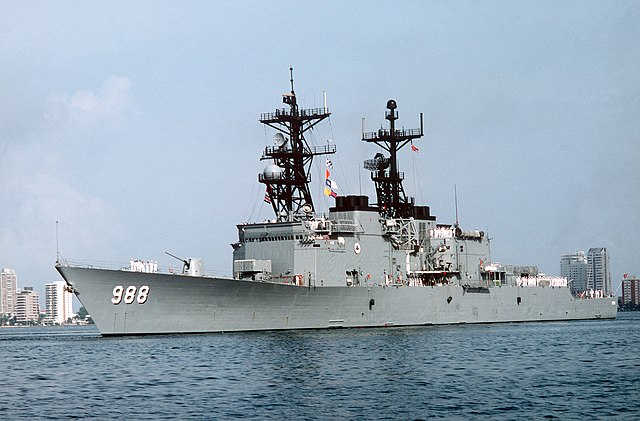
USS Thorn was laid down on 29 August 1977, launched on 22 November 1978, commissioned on 16 February 1980. Homeported to Portsmouth she had an OVL in Norfolk in 1997 after a six-month deployment to the Arabian Gulf, taking part in Operation Southern Watch and bilateral/multinational exercises. She won all four Command Excellence Awards in 1998, including the Supply Blue “E”. She became the “lunch ship” of the Standing Naval Force Mediterranean, hsoting crews from from Italy, Germany, Greece, Turkey, Spain, United Kingdom and Netherlands. USS Thorn was tailored to use extensively digital imagery and top end communication systems with maintenance facilities and repair teams aboard, managed by the new computer IT-21, allowing to share information between support activities and fleet ones, with satellite communications allowing the crews personal communication much easier. She was the first to inaugurate this system, now mainstream in the USN.
In 1999 she was deployed with USS Enterprise Battle Group, as Flagship, Commander, Standing Naval Forces Mediterranean. She departed Norfolk on November 29, 2003 with USS Cole (DDG 67) and USS Gonzalez (DDG 66) as a Surface Strike Group in the Mediterranean, using their cruise missiles. USS Thorn was decommissioned and stricken on 25 August 2004, sunk as target 22 July 2006 on the East Coast.
 USS Deyo DD-989
USS Deyo DD-989
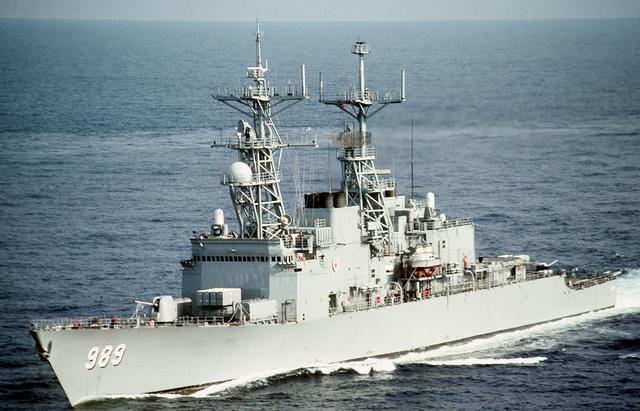
USS Deyo was commissioned on 22 March 1980, she took part in operations in the Atlantic and Eastern Pacific, Caribbean and Mediterranean as well as the Persian Gulf. First deployed in May 1981 in the Persian Gulf and by July 1987 in the the Mediterranean, North Arabian Sea and the Indian Ocean in Iowa Battleship battle group. In 1989 she took part in Operation Earnest Will.
In 1990 she operated in counter-drug operations, Caribbean Sea and returned to the Mediterranean in May 1991 (Forrestal CVBG). She took part also in the 50th Anniversary Celebrations of The Battle of the Atlantic. Back to the Med in 1994 she served with USS George Washington CVBG. By June 1996 she collided from USNS Gilliland (T-AKR-298) while moored at Newport News due to a sudden windstorm. This caused considerable damage and repairs.
In June 1998, she returned to the Mediterranean as flagship, Standing Naval Force Mediterranean. She made her final deployment in December 2002 with USS Harry S Truman CVBG, firing Tomahawk cruise missiles on Iraqi targets (Operation Iraqi Freedom) and had armored box launchers later swapped for the Mk 41 VLS (which avoided topweight and seakeeping issues). She was decommissioned on 6 November 2003 at NS Norfolk, stricken on 6 April 2004, sunk as target 25 August 2005.
 USS Ingersoll DD-990
USS Ingersoll DD-990
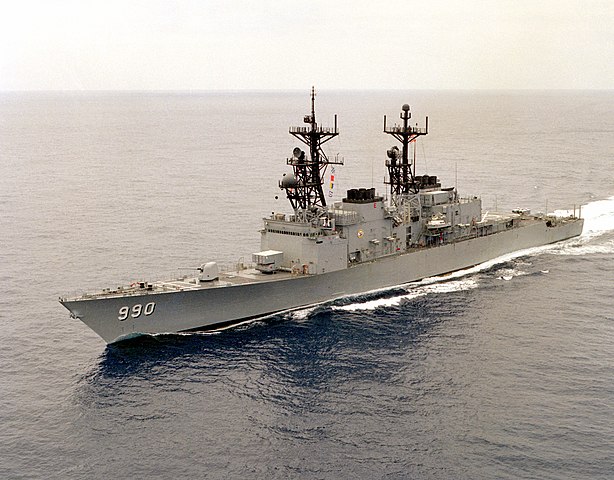
USS Ingersoll was commissioned on 12 April 1980, homeported in San Diego and then Long Beach for an for overhaul and finally Pearl Harbor. She was among the first to received the Armored Box Launcher version of the Tomahawk in 1985. She followed the same routine ops as her sisters between the Western Pacific, Indian Ocean, and Middle East, red and arabian seas. On 20 June 1992 while transiting through Malacca strait, she collided with Pakistani oil tanker M/V Matsumi Maru No. 7. She had a small gush and flooding was minimal so she was able to reach Singapore for temporary repairs, completed in Pearl Harbor and followed by an began overhaul. She was among the earliest to be decommissioned and removing the Armored Box Launcher to retrofit the VLS was such it conducted to this early decommissioning as some of her sisters. She was stricken on 24 July 1998, sunk as a target on 29 July 2003 off Kauai.
 USS Fife DD-991
USS Fife DD-991
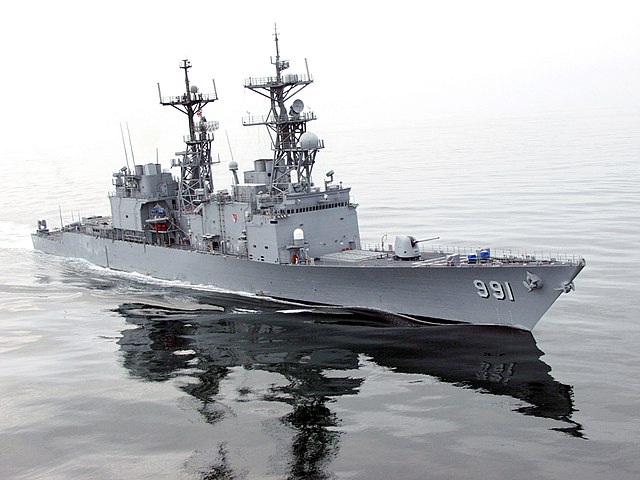
USS Fired was commissioned on 31 May 1980. She had a well-filled career on the same operating areas as her sisters, but based on the west coast for the pacific fleet. Between 27 June and 11 July 2002, she became Task Group flagship, Pacific for UNITAS off Chile. She was also deployed for 5 months in the Eastern Pacific for Counter-Drug Operations, homeported in Everett, Washington under command of CDR Frank Ponds for these last missions. She was decommissioned on 28 February 2003, stricken on 6 April 2004, sunk as a target in a live-fire exercise, on 23 August 2005 by USS Russell (DDG-59).
 USS Fletcher DD-992
USS Fletcher DD-992
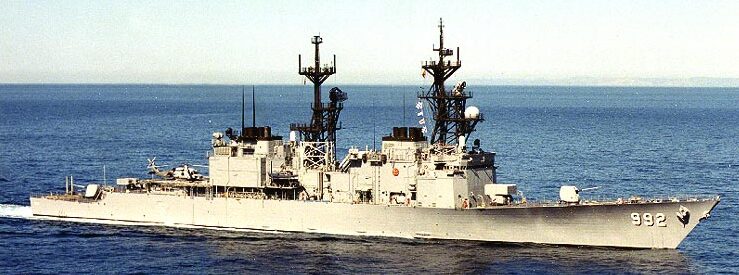
USS Fletcher, second of the name, was commissioned in July 1980, and joined the Pacific Fleet. From 1982, she made regular deployments to the western and southern Pacific, as well as Indian Ocean and later Persian Gulf areas. 1994-1995 saw her radically modernized with VLS notably. Her first started on 20 July 1983 with USS Ranger CVBG from San Diego, but rerouted to Central America for intensve training off Nicaragua, El Salvador and Honduras. Next, Battle Group Echo sailed to the Indian Ocean after coasting off Vietnam in international waters. She later operated in the North Arabian Sea and back to San Diego on 29 February 1984.
On 2 August 2002 she took part in Operation “Sea Swap” and attempt to swap crew and allow the ship to stay operational for 400 days. This was done under Cmdr. Thomas Neal in Yokosuka, Hong Kong and Singapore but she served on the Persian Gulf for Maritime Interdiction Operations. She swapped crew in Fremantle, Australia to USS Kinkaid allowing Fletcher to return to the Persian Gulf for six-month while Fletcher crew ended in Pearl Harbor. She was decommissioned and stricken 1 October 2004, was to be sold to Chile but in 2005 to Pakistan, but it never happened in the end and by 16 July 2008, she was sunk with the RAN in a new torpedo test exercise, by HMAS Waller with a single Mk48 Mod7 ADCAP torpedo in shallow water. She broke in half.
 USS Hayler DD-997
USS Hayler DD-997
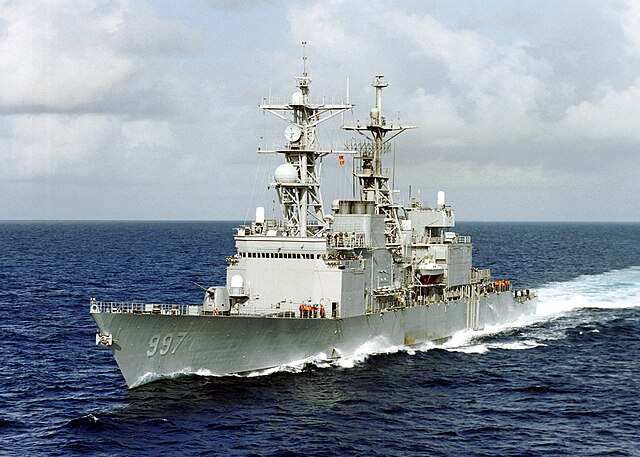
USS Hayler was laid down on 20 October 1980, launched on 2 March 1982, Acquired by the Navy on 10 February 1983 and Commissioned on 5 March. Her 1983-88 period was the usual serie of sea trials, shakedown, and weapons qualifications and exercies on the east coast, she started overseas deployment to Europe. On 23 October 1988, she collided with West German replenishment tanker Rhön, badly damaged aft and under repair at Rosyth until 20 November.
Later, assigned as escort of USS La Moure County (LST-1194) she accidentally ran aground near Caleta Cifuncho Bay (Chile) on 12 September 2000 during routine amphibious training with Chilean Valdiva. No record so far. Hayler was decommissioned on 25 August 2003 at Norfolk, stricken on 6 April 2004, and sunk as target on 13 November 2004.
Note: First published Nov, 18, 2017

 Latest Facebook Entry -
Latest Facebook Entry -  X(Tweeter) Naval Encyclopedia's deck archive
X(Tweeter) Naval Encyclopedia's deck archive Instagram (@navalencyc)
Instagram (@navalencyc)





 Austrian Navy
Austrian Navy French Navy
French Navy Royal Navy
Royal Navy Armada Espanola
Armada Espanola K.u.K. Kriegsmarine
K.u.K. Kriegsmarine Dansk Marine
Dansk Marine Nautiko Hellenon
Nautiko Hellenon Koninklije Marine 1870
Koninklije Marine 1870 Marinha do Brasil
Marinha do Brasil Osmanlı Donanması
Osmanlı Donanması Marina Do Peru
Marina Do Peru Marinha do Portugal
Marinha do Portugal Regia Marina 1870
Regia Marina 1870 Nihhon Kaigun 1870
Nihhon Kaigun 1870 Preußische Marine 1870
Preußische Marine 1870 Russkiy Flot 1870
Russkiy Flot 1870 Svenska marinen
Svenska marinen Søværnet
Søværnet Union Navy
Union Navy Confederate Navy
Confederate Navy Armada de Argentina
Armada de Argentina Imperial Chinese Navy
Imperial Chinese Navy Marinha do Portugal
Marinha do Portugal Mexico
Mexico Kaiserliche Marine
Kaiserliche Marine 1898 US Navy
1898 US Navy Russkiy Flot
Russkiy Flot French Naval Aviation
French Naval Aviation Russian Naval Aviation
Russian Naval Aviation Sovietskiy Flot
Sovietskiy Flot Royal Canadian Navy
Royal Canadian Navy Royal Australian Navy
Royal Australian Navy RNZN Fleet
RNZN Fleet Chinese Navy 1937
Chinese Navy 1937 Kriegsmarine
Kriegsmarine Chilean Navy
Chilean Navy Danish Navy
Danish Navy Finnish Navy
Finnish Navy Hellenic Navy
Hellenic Navy Polish Navy
Polish Navy Romanian Navy
Romanian Navy Turkish Navy
Turkish Navy Royal Yugoslav Navy
Royal Yugoslav Navy Royal Thai Navy
Royal Thai Navy Minor Navies
Minor Navies Albania
Albania Austria
Austria Belgium
Belgium Columbia
Columbia Costa Rica
Costa Rica Cuba
Cuba Czechoslovakia
Czechoslovakia Dominican Republic
Dominican Republic Haiti
Haiti Hungary
Hungary Honduras
Honduras Estonia
Estonia Iceland
Iceland Eire
Eire Equador
Equador Iran
Iran Iraq
Iraq Latvia
Latvia Liberia
Liberia Lithuania
Lithuania Mandchukuo
Mandchukuo Morocco
Morocco Nicaragua
Nicaragua Persia
Persia San Salvador
San Salvador Sarawak
Sarawak Uruguay
Uruguay Venezuela
Venezuela Zanzibar
Zanzibar Warsaw Pact Navies
Warsaw Pact Navies Bulgaria
Bulgaria Hungary
Hungary

 Bundesmarine
Bundesmarine Dutch Navy
Dutch Navy Hellenic Navy
Hellenic Navy Marina Militare
Marina Militare Taiwanese Navy
Taiwanese Navy Chinese Navy
Chinese Navy Indian Navy
Indian Navy Indonesian Navy
Indonesian Navy JMSDF
JMSDF North Korean Navy
North Korean Navy Philippines Navy
Philippines Navy ROKN
ROKN IDF Navy
IDF Navy Royal New Zealand Navy
Royal New Zealand Navy Egyptian Navy
Egyptian Navy South African Navy
South African Navy

































 RN
RN
 Marine Nationale
Marine Nationale
 Soviet Navy
Soviet Navy
 dbodesign
dbodesign